DashClicks Blog
The industry's top experts offer their best advice, research, how-tos, and insights—all in the name of helping you level-up your business and online marketing skills.
Join Us!

Beyond Rankings: Advanced KPIs to Track in White Label SEO Campaigns
Search engine rankings feel great — nothing signals success quite like seeing a client’s website move up to page one. But if you care about long-term success and real business impact, rankings are only the beginning. For agencies working with white label SEO partners, it’s essential to track deeper, more meaningful performance metrics. These advanced indicators show what really matters: traffic, engagement, conversions, and client satisfaction.
In this post, we’ll explore the most powerful metrics to measure beyond keyword positions, explain why they matter, and show how a white label SEO partner helps agencies deliver those results under their own brand.
Why “Beyond Rankings” Matters?
Many agencies stop at “we moved the site up on Google.” But for a business paying for SEO, what truly counts is what happens after users find their site. Think about it:
- A top-ranking page that gets no clicks adds little value.
- A site with high bounce rates wastes traffic.
- Page one rankings don’t guarantee conversions or revenue.
Focusing on advanced KPIs aligns your SEO program with real business goals — leads, sales, and retention. It improves transparency, trust, and long-term client satisfaction.
Plus, it gives you data to show return on investment (ROI). This matters especially when you’re reselling white label SEO: your clients expect more than just vanity metrics.
Advanced KPIs to Measure
Here’s a deeper look at useful KPIs beyond rankings and what they reveal about the overall health of an SEO campaign.
1. Organic Traffic and New Users
Looking at total organic traffic and the number of new users helps you see how many people are discovering your client’s site through search. These numbers tell you whether visibility is improving and whether your content is reaching the right audience.
Total organic sessions reflect search-driven volume. When this trend increases over several months, it usually shows stronger visibility, better search presence, and content that aligns with what users want.
The ratio of new vs returning organic users adds more context. High new-user numbers indicate your SEO is reaching new audiences and expanding the client’s presence. If the majority of traffic consists of returning visitors, it may signal the need to broaden keyword targeting, publish new content types, or explore untapped search opportunities.
Why it matters: Traffic opens the door to conversions and sales. High rankings only matter if people are actually visiting the site.
2. Click-Through Rate (CTR) from Search Results
Click-through rate measures how many people who see your page in search results actually click on it. It’s one of the fastest ways to understand whether your titles and descriptions are compelling.
A solid CTR (often somewhere between 3 and 10 percent depending on competition and intent) usually shows that your title tags, meta descriptions, and snippets match what users are looking for.
If you see strong rankings paired with a weak CTR, that’s a sign to improve meta tags, enhance schema markup for better rich snippets, or revise content to better match search intent. Even small adjustments can make a noticeable impact.
A healthy CTR ensures your visibility turns into website visits instead of impressions that go to waste.
3. Bounce Rate and Dwell Time / Session Duration
These engagement metrics help you understand how visitors interact with your site once they arrive.
Bounce rate measures how many people leave after viewing only one page. A high bounce rate often means the content, layout, or loading experience didn’t meet their expectations. It can also point to mismatched keywords or vague headlines that attract the wrong audience.
Average session duration and pages per session offer more insight into engagement. Longer sessions and multiple page views usually mean your content aligns with user intent, answers key questions, and encourages people to explore further.
Tracking bounce rate and engagement over time helps you refine navigation, page speed, structure, and content depth so visitors stay longer and get more value from the site.
4. Conversion Rate (CVR) and Goal Completions
The real purpose of SEO isn’t just visibility. It’s an action. Whether that’s booking an appointment, completing a purchase, filling out a form, or signing up for a newsletter, conversions are what clients care about.
Conversion rate measures how well organic traffic turns into meaningful actions. Tracking CVR over time shows whether your SEO work is attracting qualified visitors who are ready to move forward.
Goal completions reflect the actual number of leads, sign-ups, downloads, or purchases. They give you a clear view of the value your SEO work delivers instead of relying only on traffic trends.
For many businesses, these numbers hold more weight than rankings or impressions because they directly affect revenue.
Further Reading: Conversion Rate Optimization (CRO): 8 Ways to Get Started
5. Return on Investment (ROI) and Cost per Acquisition (CPA)
If you know how many organic conversions occurred and the average value of each customer, you can start calculating financial performance, which is essential for long-term planning.
Cost per acquisition shows how much it costs to secure a lead or customer through SEO efforts. If CPA drops over time, it’s a sign the campaign is becoming more efficient.
ROI helps you understand whether the client’s SEO investment is paying off. Showing that organic search contributes more revenue than it costs is one of the most powerful ways to reinforce the value of ongoing SEO.
These financial KPIs help agencies demonstrate transparency, justify budgets, and make smarter decisions about where to invest next.
6. Backlinks & Referring Domains Quality
SEO still depends significantly on off-site signals. But instead of just counting backlinks, focus on quality and relevance:
- Number of new referring domains (especially authoritative ones).
- Domain authority or trust metrics.
- Ratio of do-follow to no-follow links (depending on strategy).
Quality backlinks improve authority and long-term ranking stability.
7. Page Speed & Core Web Vitals
User experience matters. Search engines — and users — increasingly value performance.
- Measure page load times, First Contentful Paint (FCP), Largest Contentful Paint (LCP), and Cumulative Layout Shift (CLS).
- Fast, stable pages reduce bounce and improve engagement, especially on mobile.
With mobile traffic now dominating global web usage, performance matters more than ever.
8. Local SEO Signals
For local businesses, these matter a lot:
- Consistency of business listings and citations (Name, Address, Phone).
- Reviews and review growth rate.
- Local search traffic and conversions.
Measuring these helps build visibility for local queries and drives real customers through the door.
9. Content Engagement & Quality Signals
When your campaign includes content marketing (blogs, articles, guides), these metrics reveal its impact:
- Shares, social engagement, time on page — show how valuable the content is to readers.
- New organic keywords discovered per piece of content — indicates content is ranking for long-tail queries over time.
- Internal link performance — which pages keep users engaged and reduce bounce.
Strong content performance strengthens your site for long-term growth.
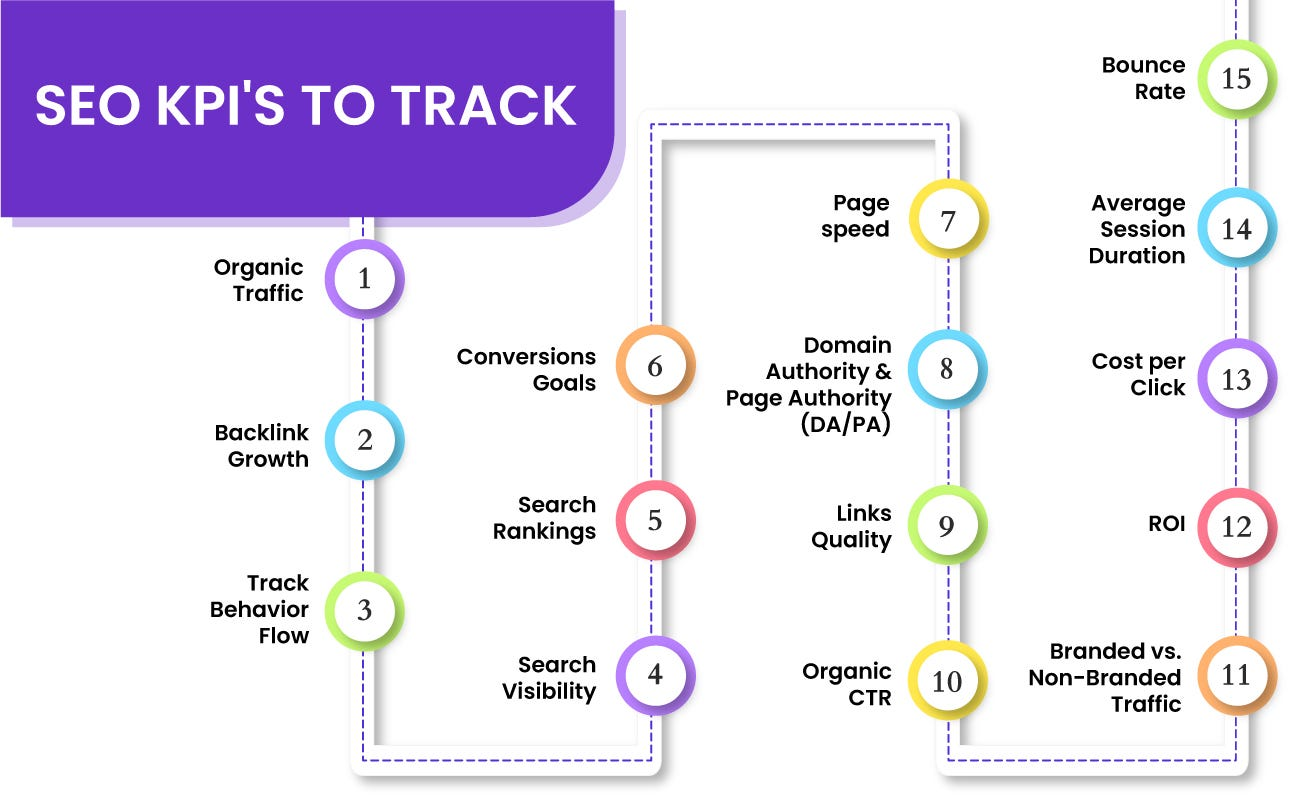
Image Source: Medium
How DashClicks Makes Tracking Advanced KPIs Easy for Agencies?
DashClicks offers fully white label SEO services along with a unified dashboard, which simplifies tracking and reporting on advanced KPIs. Here’s how it fits in with the advanced KPI approach:
- DashClicks handles essentials like technical audits, content optimization, link-building, and page-speed improvements, ensuring the technical and SEO foundations are strong.
- Through its dashboard, agencies get real-time reports — showing organic traffic, conversions, backlink growth, and site performance — all under their own brand.
- Agencies don’t need to buy expensive tools like SEMrush or Ahrefs on their own. DashClicks gives access to data-driven SEO analytics through its fulfillment model.
- The scalable, white-label model lets agencies handle many clients with predictable workflows while delivering consistent, quality SEO results — making it easier to track KPIs across multiple client campaigns without chaos.
In short, DashClicks helps you go beyond just monitoring “Where do we rank?” — you can show clients the full picture: traffic, engagement, conversions, and value.
Best Practices for Measuring Advanced SEO KPIs
- To get the most value from your tracking and reporting, it helps to follow a consistent approach that keeps data accurate, meaningful, and easy for clients to understand.
- Set clear baseline data at the start. Before making any optimization changes, record current traffic levels, conversion counts, bounce rates, engagement metrics, and ranking positions. Baseline data gives you a reliable point of comparison and makes it easier to show progress over time.
- Segment data by traffic source and device. Breaking down organic, paid, referral, direct, and social performance highlights how each channel contributes to growth. Device segmentation helps you see whether mobile users behave differently from desktop visitors, which can uncover UX issues or content gaps.
- Use conversion tracking and goals in your analytics setup. Make sure every important action is being tracked correctly, whether it’s a form submission, phone call, purchase, download, or time-based goal. Without clean tracking, it’s impossible to evaluate the quality of organic traffic or understand what’s driving results.
- Report on a regular schedule, either monthly or quarterly. Consistent reporting helps you identify patterns, seasonal trends, early warning signs, or sudden drops that need attention. It also allows you to communicate progress in a clear and timely way.
- Compare metrics over meaningful periods, not just month to month. Month-to-month shifts can be noisy due to holidays, algorithm updates, or natural fluctuations. Quarterly or year-over-year comparisons give you a more stable view of long-term progress.
- Communicate KPIs in a way clients can easily understand. Go beyond numbers by explaining what each metric means and why it matters. Help clients see that rankings or traffic growth are valuable, but engagement and conversions are stronger indicators of real performance. Clear explanations make it easier for clients to appreciate the full impact of your SEO work.
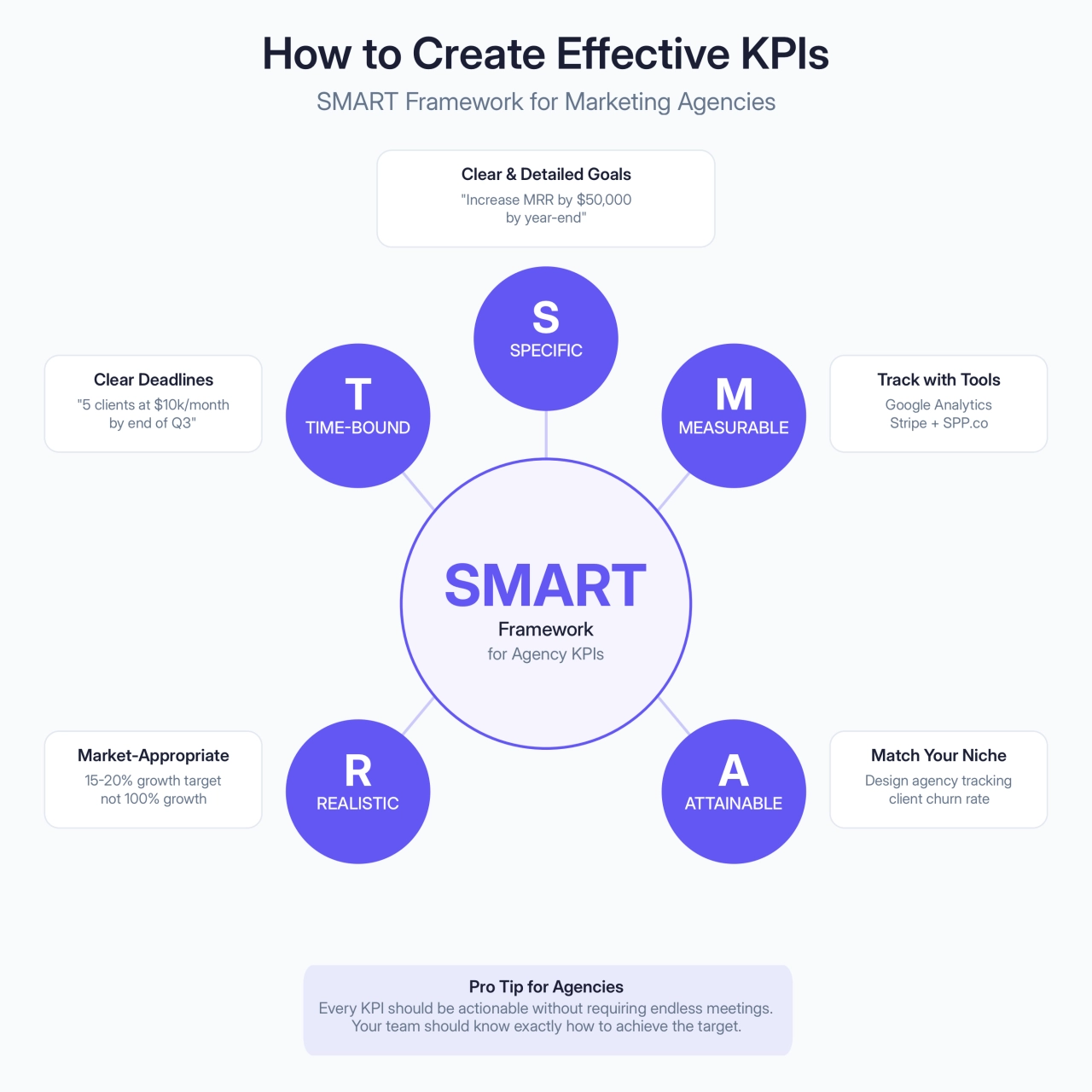
Image Source: Service Provider Pro
Why Advanced KPIs Matter More Now Than Ever?
SEO has evolved. Algorithms constantly shift. User expectations have risen. Here’s why deeper KPIs matter more than ever:
- Search engines now reward page experience, mobile performance, and user engagement — not just backlinks or content.
- With more content online than ever, competition is fierce. Quality, relevance, and user experience make the difference.
- Businesses expect measurable ROI. They want revenue, leads, or real conversions — not just “top 10 ranking.”
- Over time, advanced KPIs help spot problems early: a site might lose conversions even with stable traffic (bad UX or broken links), or gain traffic but lose engagement (weak content).
Challenges and How to Overcome Them?
Measuring advanced KPIs is not without challenges. Here are some common issues:
1. Data Overload — Too many metrics can overwhelm.
Solution: Focus on 4-6 key metrics per client (e.g., organic traffic, conversions, bounce rate, page speed, backlink growth, CTR).
2. Attribution Difficulties — Not all conversions are from organic SEO.
Solution: Use clear tracking (UTM tags, analytics goals) and distinguish organic vs other channels.
3. Slow ROI on SEO — SEO takes time; conversions may lag.
Solution: Set realistic timelines (many campaigns show strong results in 3–6 months) and report interim progress (traffic, engagement).
4. Client Misalignment — Clients may care only about rankings.
Solution: Educate them early about the value of deeper KPIs. Show how rankings + conversions = business growth.
Conclusion
Focusing solely on keyword rankings is like judging a movie by its poster — it gives a hint, but not the full story.
Advanced KPIs reveal what truly matters: whether real people visit the site, stay engaged, convert, and come back. They help you build transparency, trust, and lasting value for your clients.
By tracking metrics like organic traffic, CTR, bounce rate, conversions, backlinks, page speed, and engagement — and by presenting them clearly and regularly — you can transform SEO from a vanity service into a measurable engine for growth.
If you partner with a white label SEO agency like DashClicks, you gain access to tools, data, reporting, and white label dashboards that make advanced KPI tracking effortless and scalable. DashClicks doesn’t just help you hit higher rankings — it helps you deliver real performance, under your brand.
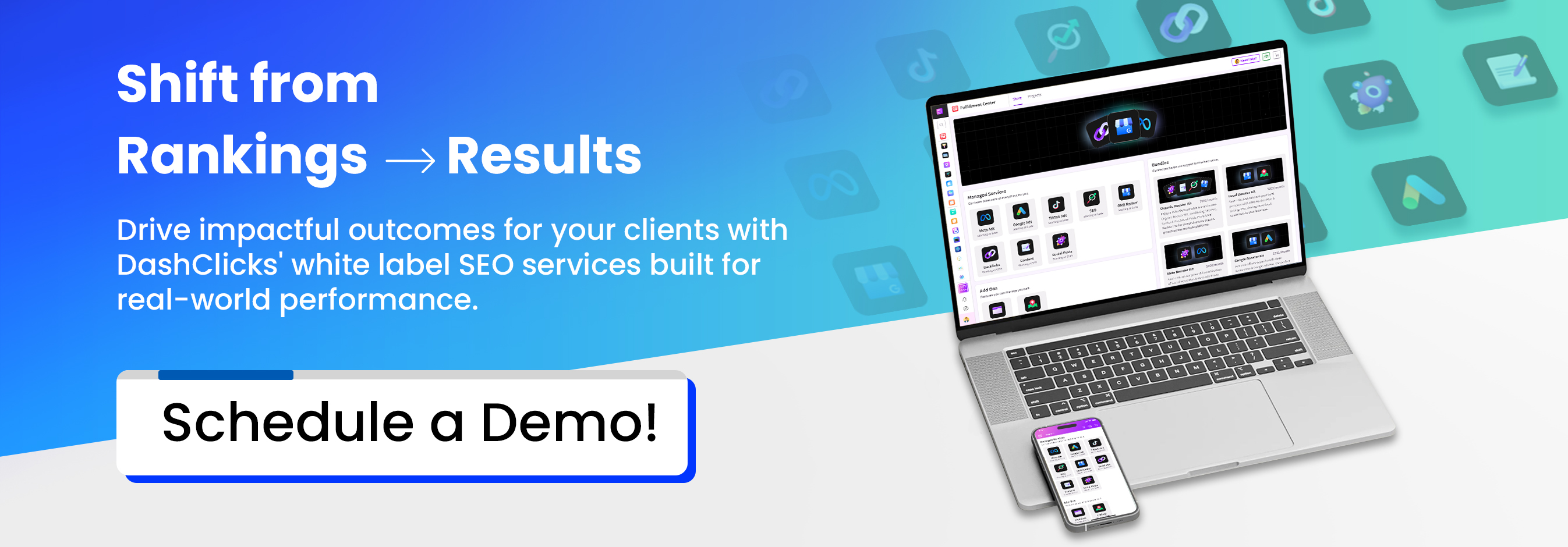

From Clicks to Conversions: How White Label PPC Improves Funnel Performance
Paid advertising continues to be one of the most reliable ways for businesses to create predictable demand. What has changed is the way audiences behave. People move across platforms, consume more content, compare more options, and expect faster, more relevant experiences. At the same time, bidding systems grow more sophisticated, data privacy rules tighten, and cost-per-click increases across competitive verticals. All of this puts more pressure on agencies to manage the entire funnel with greater precision, not just the top of it.
Recent benchmark studies show that average Google Ads conversion rates vary widely by industry. For example, e-commerce search campaigns often hover around 2.8 percent, while blended averages across various sectors have reached roughly 7.5 percent, depending on the account mix. These numbers highlight a simple truth. When campaigns, audiences, and landing pages work together, the gap between a click and a conversion closes fast.
Many agencies know what needs to be done but struggle with capacity, specialist skills, and the ability to run tests at the speed the platforms demand. That’s where white label PPC management becomes a practical solution. More agencies are turning to PPC outsourcing to stay competitive, maintain quality, and keep their clients happy. Industry surveys show continued growth in outsourced paid media support, especially among small to mid-sized agencies.
This guide walks through the real reasons agencies lose conversions and how white label PPC services can improve funnel performance. It’s a tactical playbook, not a sales pitch. You’ll see the roadblocks, the capabilities you should expect, and the systems that turn paid traffic into revenue more consistently.
What Stops Agencies From Converting Clicks Into Predictable Revenue?
Agencies rarely struggle to drive traffic. The real challenge is converting that traffic into qualified leads or sales.
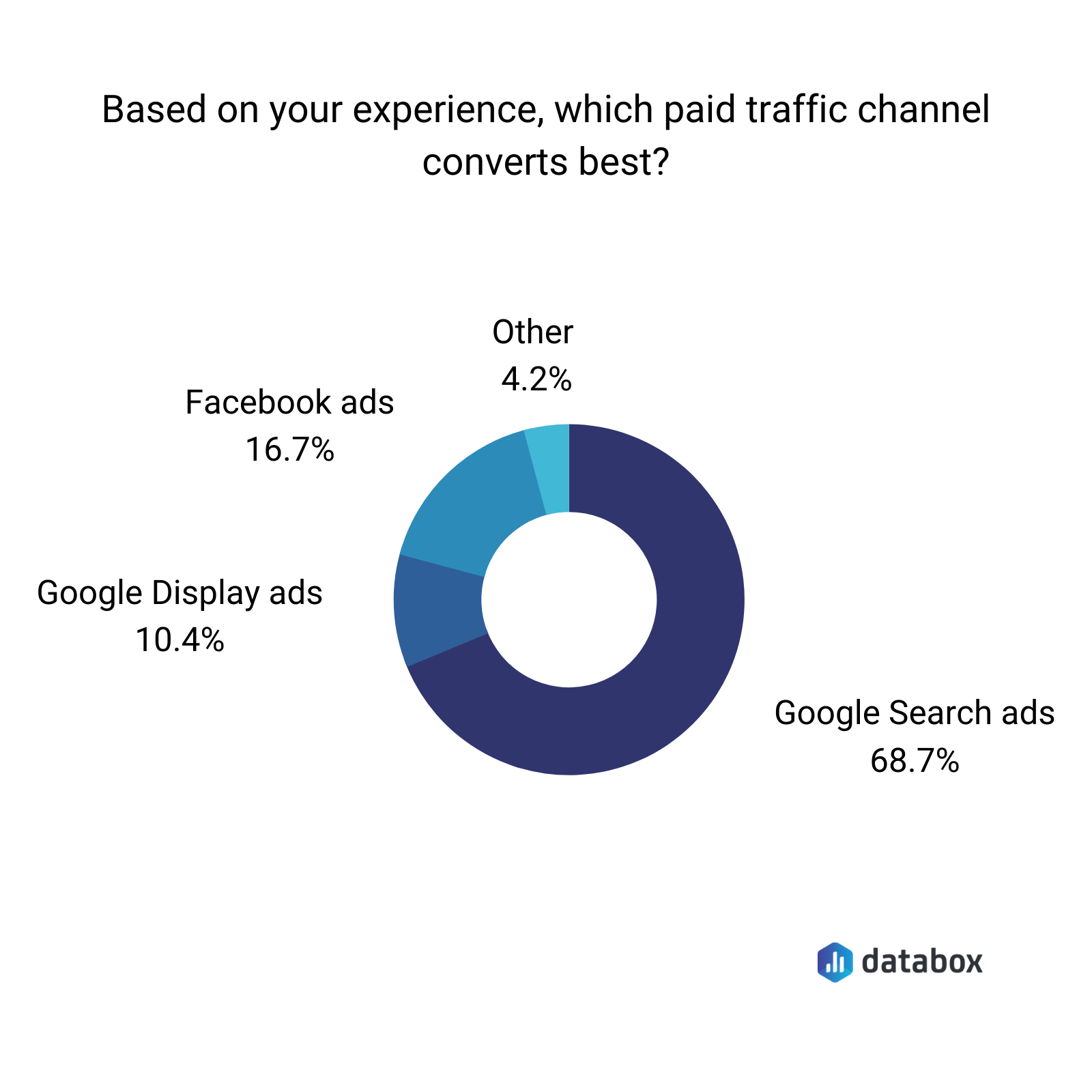
Image Source: Databox
Here are the most common issues that get in the way, along with examples of how they affect performance.
1. Limited Skills and Bandwidth When Scaling
Running high-performing paid campaigns across multiple networks requires different specialists. Search, Shopping, YouTube, Performance Max, Discovery, and retargeting all behave differently. Agencies with small teams can manage a few accounts well, but continuous optimization becomes difficult as the client list grows.
A common symptom is a slow A/B testing cadence. When an agency is stretched thin, creatives stay active for too long, click-through rates decline, and the account loses momentum. Without rapid rotation, quality scores drop, and CPCs climb.
2. Fragmented Workflows Between Campaigns, Landing Pages, and CRO
Many agencies focus heavily on the ad side and leave landing pages, design, and conversion rate optimization to separate teams or freelancers. This disconnect leads to mismatched messaging and poor user experience.
For example, an ad may promise a specific offer, but the landing page might lead with different benefits. Even small inconsistencies cause friction, reducing conversions and increasing bounce rates.
3. Tracking and Attribution Issues
Accurate tracking is a major bottleneck for many agencies. Common issues include:
- Misconfigured conversion actions
- Cross-domain tracking errors
- Missing event parameters
- Lack of server-side tracking
- Gaps in CRM integrations
When conversions are underreported or misattributed, agencies lose visibility into what actually drives results. That makes it hard to optimize, justify budgets, or prove ROI.
4. Slow Experimentation and Learning Cycles
Paid platforms reward advertisers who adapt quickly. When an agency updates ads slowly or tests one variable at a time over long periods, performance stagnates. This is especially painful when CPCs rise.
A slow testing process limits actionable insights, reduces lift, and delays improvements that could lower cost-per-acquisition.
5. Rising CPCs and Margin Pressure
Across many industries, CPCs have increased year over year. Agencies must extract more value from every click to sustain profitability. Without deep optimization and strong landing page performance, rising CPCs erode margins and frustrate clients.
6. Inconsistent Reporting and Misaligned Expectations
Clients don’t want reports full of impressions and clicks. They want clarity on leads, revenue, lifetime value, and return on ad spend. Agencies that provide surface-level dashboards often face churn because clients can’t see the true impact.
Each of these challenges aligns with the capabilities a strong white label PPC partner can provide. The following section breaks down the specific systems agencies should expect from a partner who truly supports full-funnel performance.
How White Label PPC Improves Funnel Performance?
A strong white label PPC partner gives agencies access to specialized skills, faster testing cycles, more accurate tracking, and better reporting. Below are nine tactical capabilities that directly improve funnel results.
1. Full-Funnel Campaign Design
Strong PPC campaigns guide users from first touch to final conversion instead of treating every click the same. A well-built funnel assigns each campaign type to a clear role in the buyer journey. Discovery and YouTube work best for building awareness and introducing your offer to new audiences. Search and Shopping take over when people are actively comparing options and showing high intent. Remarketing steps in when someone is close to making a decision and just needs a final push.
When campaigns line up with user intent, budgets work harder, messaging feels more relevant, and conversion rates usually rise. A good partner will map out a full-funnel plan that outlines audience segments, creative direction, and budget recommendations for each stage so agencies can see exactly how the pieces fit together.
2. Rapid Creative and Copy Rotation
Creative fatigue can set in fast, especially on platforms with heavy impression volume. That’s why high-performing accounts rely on steady creative rotation. A strong partner should be able to produce and test 15 to 30 new ad variations each month for every funnel stage. This pace keeps campaigns fresh and drives steady improvement.
Regular rotation helps maintain healthy click-through rates, supports stronger quality scores, lowers CPCs, and often leads to better conversion performance. Ask for a creative testing log that shows when new ads were launched, how they performed, and which insights came from each round of testing.
3. Post-Click Optimization and CRO Support
A big share of lost conversions happens after the click, not in the ad itself. Landing pages that are slow, cluttered, or unclear make even the strongest campaigns struggle. A partner with dedicated conversion rate optimization expertise can help fix these issues before they hurt performance.
Support should include fast, conversion-focused landing page templates, personalization options that match user intent, structured A/B or multivariate testing, and form improvements that reduce friction. Even small gains in conversion rate add up. A lift of 5 to 15 percent on landing pages can sharply reduce CPA over time. A reliable partner will be able to show past CRO tests and the measurable improvements they produced.
4. Advanced Measurement and Attribution
Accurate tracking is the foundation of effective PPC campaigns for agencies. A solid white label PPC partner should be able to manage server-side setups, build clean GA4 event architecture, configure conversion API integrations, and import CRM or offline conversions. They should also understand how to apply attribution modeling that reflects the full customer journey.
With the right measurement in place, agencies can focus on revenue-driving actions rather than surface-level numbers. A capable partner should be able to share a data architecture outline and a sample attribution model to show how each touchpoint is evaluated.
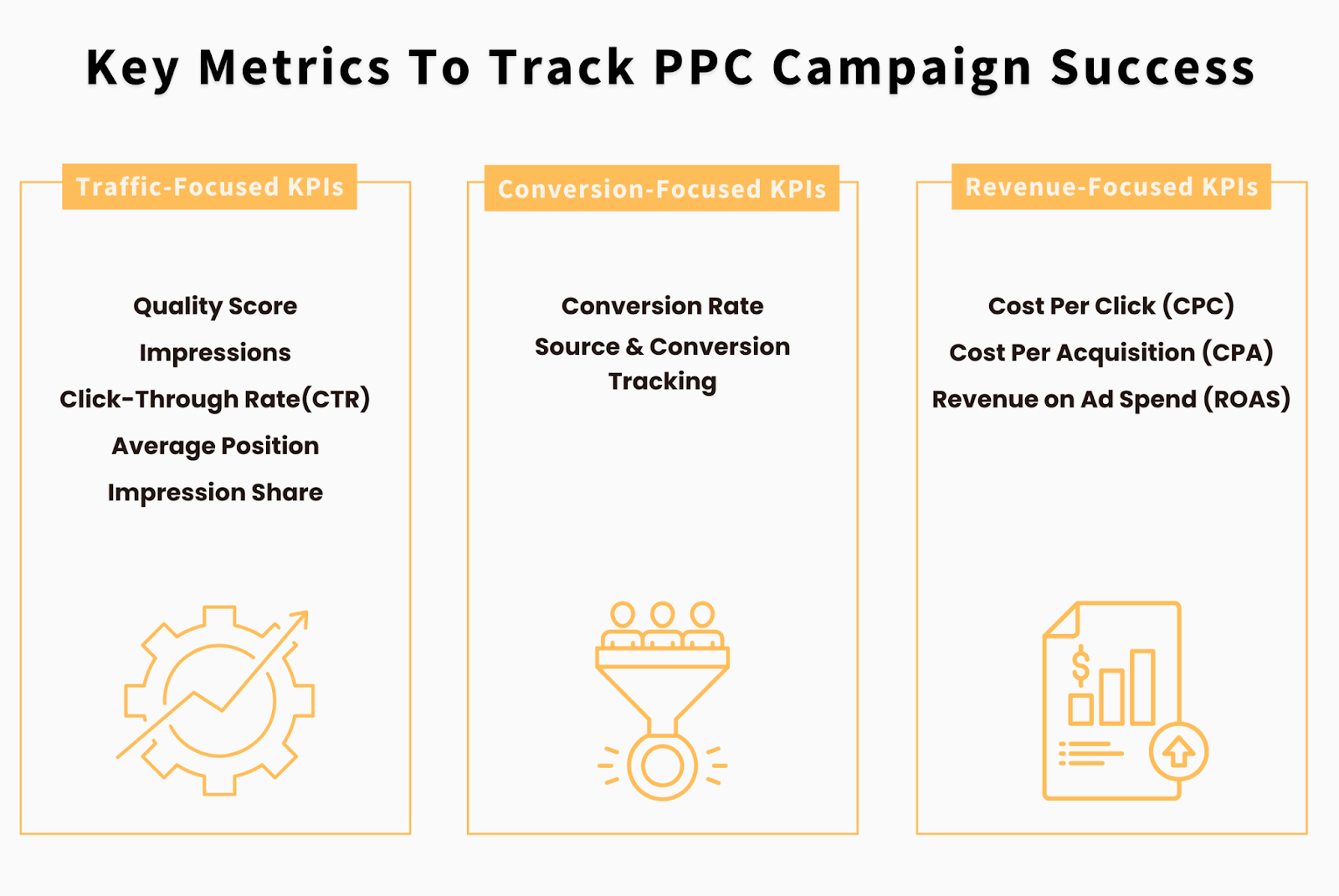
5. Audience Engineering and Remarketing Structures
Audience structure is one of the biggest levers for improving funnel performance. A strong partner will create layered audience stacks that include engagers, past converters, high-value lookalike groups, and structured sequential remarketing. These layers help connect the right message to the right user at the right time.
When audiences are aligned with intent, ROAS tends to rise naturally because every stage of the funnel becomes more efficient. A good partner should provide a clear target audience taxonomy and rules for how bids and budgets shift based on lifetime value or predicted intent.
6. Cross-Channel Media Coordination
Modern funnels rarely stay within one platform. Users move between search, social, video, and display, so messaging needs to stay consistent across all touchpoints. A reliable white label PPC partner will manage coordinated campaigns across Search, Performance Max, Discovery, YouTube, social retargeting, and Connected TV when it fits the strategy.
Cross-channel alignment shortens the path to purchase, strengthens brand recognition, and can even increase average order value. The goal is to guide users smoothly from first impression to final conversion, no matter where they interact with the brand.
Further Reading: Cross-Channel Marketing: What It Is, Major Benefits + How to Get Started
7. Programmatic Capability and Automation
Automation has become essential for keeping campaigns responsive. A strong partner knows how to use rules-based bidding, automated scripts, portfolio bidding, and programmatic placements to adjust quickly based on performance trends. These tools make campaigns more agile than manual changes alone.
With a proper automation framework, budgets shift toward winning segments faster, wasted spend drops, and overall efficiency improves. It’s reasonable to ask for an automation playbook that outlines how these systems are used and which indicators trigger adjustments.
8. Faster Experimentation and Regular Learning Cycles
High-performing accounts rely on steady testing. A white label PPC partner should run structured experiments each month and supply a testing calendar that shows what’s coming next. Each test should include a clear hypothesis, success benchmarks, and a summary of insights once results come in.
This steady learning cycle helps campaigns improve predictably instead of relying on guesswork. The more consistent the testing rhythm, the more reliable the long-term performance gains.
9. Reporting Built for Conversions
Reports should go beyond surface metrics and focus on what actually impacts revenue. That includes conversion paths, cohort-level CPA, lifetime value trends, incrementality testing, and lead quality indicators. These insights help agencies tell a clearer story about performance and guide better decision-making.
With reporting that highlights true business outcomes, agencies can build stronger client relationships and show a direct link between PPC efforts and growth.
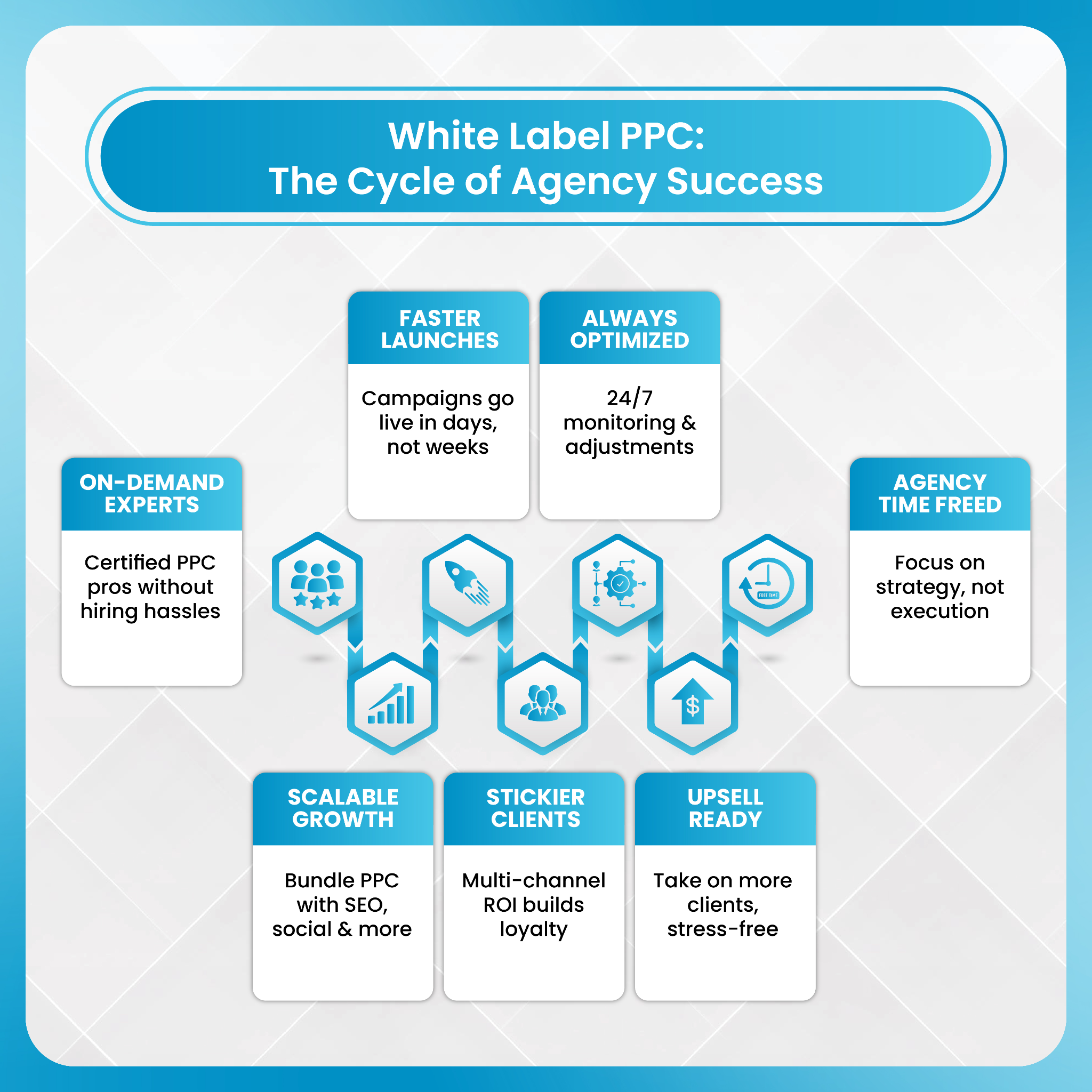
Tactical Playbooks Agencies Can Use Immediately
Here are four quick playbooks agencies can implement with the support of a white label PPC partner.
1. Lower-Funnel CPA Rescue
Goal: Reduce acquisition costs
Tactics:
- Strong remarketing sequences
- Bidding focused on conversion value
- Dynamic search ads
Expected lift: Many accounts see CPA reductions between 15 and 35 percent within two months, depending on industry and volume.
2. Scaling Without Losing Lead or Sales Quality
Goal: Grow spend while maintaining ROAS
Tactics:
- Expand winning creative themes
- Build new lookalike audiences
- Use portfolio bidding strategies
- Run incrementality tests
Expected lift: Agencies often double budgets while stabilizing ROAS through improved targeting and cross-channel reinforcement.
3. Improving Lead Quality for Service Businesses
Goal: Reduce low-quality or unqualified leads
Tactics:
- Post-click form enrichment
- Lead scoring with CRM data
- Offline conversion uploads
- Negative keyword expansion
Expected lift: Higher qualified lead rates and better alignment between marketing and sales.
4. Increasing AOV and CLTV for Ecommerce
Goal: Raise transaction value and repeat purchases
Tactics:
- Bundled or tiered offers
- On-site personalization
- Post-purchase remarketing
- Cart recovery campaigns
Expected lift: Many ecommerce brands see an 8 to 20 percent uplift in average order value when combined with strong paid media and CRO.
Commercial and Operational Considerations for Agencies
Before partnering with a white label PPC services, agencies should think about operational details that protect client trust and preserve margins.
1. Pricing and Margins
Agencies typically choose between:
- Flat monthly retainer
- Percentage of ad spend
- Hybrid model
The right structure depends on client size, niche, and internal processes. Many resell white label PPC under a tiered package structure that includes CRO support and reporting.
2. Service Level Agreements and Workflow
A reliable partner will define:
- Turnaround times for creative and campaign updates
- Reporting schedules
- Escalation paths
- Quality standards
Clear SLAs prevent surprises and maintain consistency across accounts.
3. Data, Access, and Security
Agencies should ensure:
- Secure logins and access controls
- MCC-level management
- Compliance with privacy regulations
- Proper storage and handling of client data
These steps protect both the agency and its customers.
4. Packaging White Label PPC as a Value-Add
A well-designed white label PPC management program helps agencies offer more comprehensive services. Many bundle PPC with CRO, landing pages, analytics support, and content to create stronger recurring revenue.
How DashClicks Helps Agencies Improve Funnel Performance From Clicks to Conversions?
DashClicks provides white label PPC services designed to strengthen funnel performance across every stage, from awareness to decision. The platform combines strategy, execution, and reporting in one system so agencies can offer full-service PPC without hiring new staff. Agencies gain access to specialist teams who build campaigns aligned with user intent, optimize audiences and creative assets continuously, and monitor post-click behavior to improve conversion rates.
DashClicks integrates advanced tracking setups, conversion API support, and CRM connections so attribution remains accurate and transparent. The system also includes client-facing dashboards that highlight key insights such as CPA, ROAS, funnel movement, and lead quality.
With scalable white label support, agencies maintain full ownership of client communication and branding while relying on a dependable backend team to manage execution. This structure helps agencies deliver stronger results, shorten learning cycles, and keep clients satisfied with clear, measurable progress.
A Well-Rounded Ending That Brings It All Together
White label PPC gives agencies a practical way to turn clicks into measurable business outcomes. With rising costs and more complex user journeys, agencies need systems that cover creative testing, landing page optimization, accurate tracking, and smart reporting. A partner who delivers full-funnel planning, rapid experimentation, and consistent execution helps agencies maintain strong performance without expanding internal teams.
If you want support that improves conversion rates, stabilizes ROAS, and strengthens client retention, consider running a 90-day pilot with a trusted white label provider. It’s one of the simplest ways to evaluate real impact without major risk.
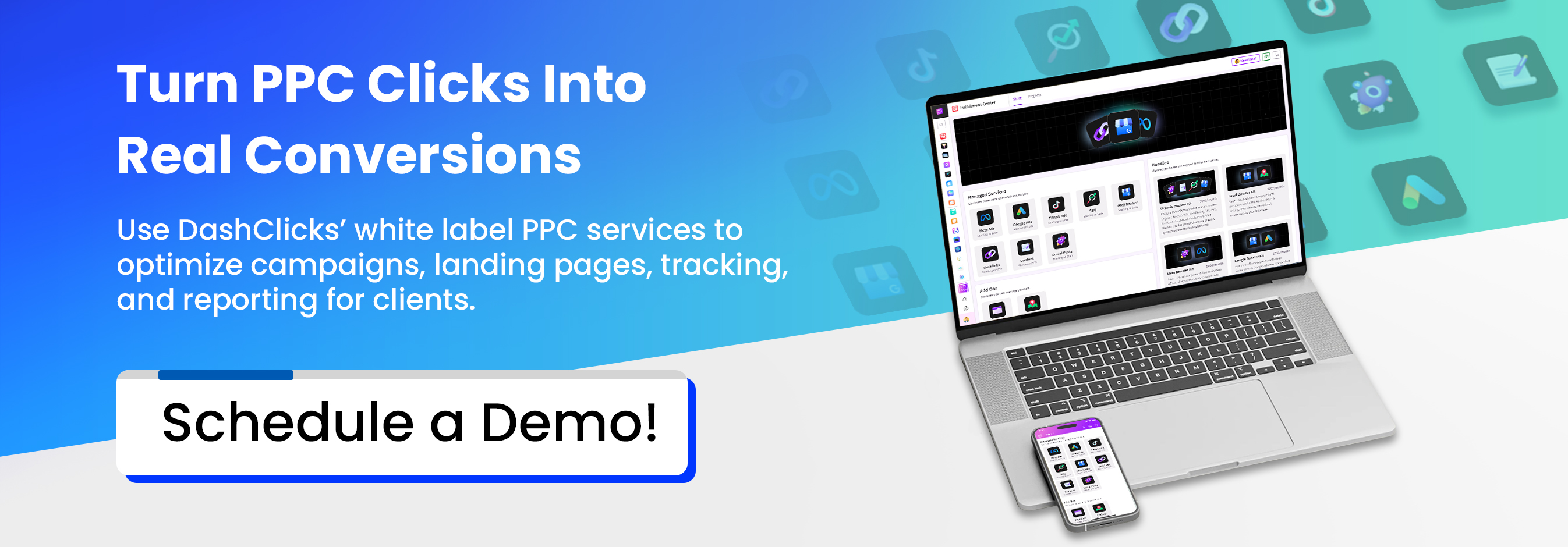

Google’s SGE: What Agencies Should Ask White Label SEO Partners
Search is changing fast. With the rise of Google’s Search Generative Experience (SGE), also known as AI Overviews, agencies and their white label SEO partners must rethink how they approach optimization. SGE adds generative summaries directly into the search results, often appearing above or beside traditional links. Because these summaries deliver quick answers, they can significantly shift how people click, scroll, and interact with search pages.
Studies released after Google expanded AI Overviews show that click-through rates for top organic results have dropped sharply, with the first result losing nearly a third of its previous clicks. Other research shows that zero-click searches have increased as users find everything they need in the AI-generated summary. All of this changes how traffic flows across the search ecosystem.
For agencies, especially smaller ones leaning on white label SEO services, these shifts raise the stakes. Clients expect guidance on SGE, not just traditional SEO. That means partnering with a white label SEO agency capable of meeting today’s search realities. If a partner can’t prove they understand SGE, the risks are simple: fewer clicks for clients, thinner margins for your agency, and shrinking trust over time.
What SGE Complicates for Small Agencies and Their Clients?
SGE doesn’t replace organic search, but it changes how people interact with it. As AI-driven summaries become a regular part of the results page, agencies are dealing with a new set of challenges that affect visibility, reporting, and content strategy.
1. Visibility Versus Clicks
AI Overviews often answer a user’s question before they ever visit a website. A quick explanation, a comparison, or a step-by-step answer can all show up in the summary itself. This makes informational queries harder to monetize because users don’t feel the need to click through. Agencies that rely on top-of-funnel traffic see this most clearly, since these queries are the ones most likely to trigger summaries.
2. Traditional Ranking Signals Are Less Reliable
Old habits like publishing long, heavily optimized posts don’t carry as much weight anymore. SGE favors content that stays focused, reads cleanly, and makes its expertise obvious within seconds. A page might hold a good organic position but still get passed over for the AI summary if the structure, clarity, or authority cues aren’t strong enough.
3. Measurement and Attribution Become Harder
When users get what they need without clicking, analytics tools miss part of the story. A page may influence a decision even if the visitor never lands on it. Agencies now need to look at wider signals such as presence in AI summaries, impressions, branded query growth, assisted conversions, and return-to-search behavior. This shifts reporting away from simple traffic numbers and towards visibility and influence.
4. Content Provenance and Trust Matter More
SGE leans heavily on content that shows its sources and expertise. Pages with bylines, citations, original insights, and clear expertise signals stand out. Content that looks vague, generic, or poorly attributed can be skipped or summarized inaccurately, which hurts both visibility and brand trust.
5. Structured Data Becomes Essential
Semantic signals are now a major factor in what SGE chooses to summarize. Schema markup, clearly defined entities, and connections to known data sources make it easier for the AI to understand and surface a page. Without structured data, content is less likely to be pulled into summaries, regardless of how well it ranks.
6. Faster Iteration is Mandatory
The old content workflow of planning, writing, editing, and publishing over several weeks no longer keeps up with SGE. AI summaries change quickly as Google refines how it interprets intent and quality. Agencies need to experiment with formats, refresh pages more often, and adjust answer blocks, FAQs, and summaries as patterns shift. The agencies that move slowly lose ground because competitors can adapt their content in days instead of months.

If your white label SEO partner can’t work at this pace or explain how they’re staying ahead of SGE, you’re exposed to drops in visibility, fewer leads, and slipping client trust. This isn’t an area where “set it and forget it” works anymore.
What Agencies Should Ask White Label SEO Partners?
The best way to protect your clients is to vet your SEO partner with clear and practical questions. Below is a list your agency can use to check whether a provider is truly prepared for SGE. Each question explains why it matters and what you should expect from a strong partner.
1. SGE Understanding and Roadmap
Start by asking how the partner defines SGE or AI Overviews and what their roadmap looks like for the next few quarters. Anyone who can’t break it down in simple terms won’t be able to build a strategy that holds up. You want a team that follows Google’s updates, tests early, and turns those insights into real processes.
A reliable partner maintains a written SGE playbook, explains how they structure content to improve the chance of being pulled into AI summaries, and shares quarterly testing results. They should be able to show what’s working now, not rely on vague predictions.
Request: A one-page SGE playbook and a few recent experiment summaries.
2. Content Format and Intent Mapping
SGE doesn’t look the same for every query. Some keywords show an overview, while others lean toward instructions or comparisons. A good partner maps these patterns to the content they produce so the structure matches the intent of the search.
A solid answer includes clear intent clusters, short lead summaries, precise answer blocks, and briefs designed to support SGE-friendly formats. If they can show how they plan content around these triggers before writing, that’s a strong sign.
Request: A content brief with a working headline, a 40–80 word summary, and citations.
3. Evidence and Citation Strategy
SGE relies heavily on strong sourcing. You should ask how the partner verifies information and keeps data accurate. Weak or unverified sources lower your visibility in AI Overviews and put your credibility at risk.
The best partners use reputable data, add inline citations, verify claims before publishing, and provide full reference lists. This helps the content earn trust signals that influence both ranking and visibility.
Request: A short article sample with inline citations and a complete source list.
4. Structured Data and Schema Optimization
Structured data gives Google context and improves your chances of being featured in SGE. Your partner should understand the most important schema types and how to apply them across different content types. This includes FAQ, how-to, article, product, and local business schema, along with custom options for niche sites.
Look for partners who use automated schema tools to keep large sites consistent. They should also be able to show where the schema made a measurable difference.
Request: Before-and-after examples showing schema updates and their impact.
5. Prompt and Snippet Testing
AI summaries are sensitive to how information is phrased. Even small changes in the opening paragraph or answer sections can influence visibility. Your partner should run prompt tests, experiment with snippet formats, and track their results.
A strong partner documents variations, compares outcomes, and shares data that shows how adjustments affected impressions or click-through rate. You want proof that they test intentionally, not guess.
Request: Two recent snippet or prompt test logs with clear outcomes.
6. SERP Feature and AI Overview Tracking
SGE visibility is a separate performance layer, and your partner needs to track it directly. If they don’t monitor AI Overviews alongside traditional rankings, you’ll miss insights that shape strategy.
Look for reporting that includes AI Overview impressions, SERP features, organic rankings, and engagement in one place. They should show visibility trends and how SGE affects client demand.
Request: A dashboard or reporting snapshot with SGE-specific tracking.
7. Attribution and KPI Reframing
SGE reduces clicks in many categories, so old performance metrics no longer tell the whole story. Ask how they rework KPIs to capture value beyond traffic alone. You need a partner who understands impression-based reporting, assisted conversions, and multi-touch attribution.
If they still measure success by clicks only, they’re not prepared for today’s search landscape. Updated metrics prove they understand the shift in user behavior.
Request: A KPI proposal that reflects current SGE realities.
8. Content Provenance and Safety
Accuracy matters more than ever with AI systems pulling data from countless sources. Ask how your partner prevents misinformation and what their review flow looks like. The goal is to reduce risk and keep your brand safe.
A strong partner uses human review, verifies claims, checks sources, and fixes errors quickly. They should be able to explain how they ensure content is safe, reliable, and trustworthy across all channels.
Request: Their content quality assurance checklist.
9. Technical SEO Readiness for SGE
SGE still relies on strong technical SEO. If Google can’t crawl or interpret your content, you won’t appear in AI Overviews. Your partner should handle site speed, internal linking, entity optimization, clean structure, and author details that add clarity.
A capable partner can share a technical audit that highlights SGE-specific opportunities like entity gaps, crawl issues, and content hierarchy problems.
Request: A technical audit sample with notes on SGE-related factors.
10. Experimentation Cadence and Fast Failure
SGE evolves fast, so your partner has to move quickly too. Ask about their testing schedule, how they track results, and how they decide when to adjust. Look for teams that run monthly experiments and document their findings in a clear, repeatable format.
A strong partner tests often, learns fast, and adapts without delay. This rhythm helps them stay ahead of the shifts in AI-generated search.
Request: A recent experiment log with takeaways.
Tactical Checklist — Proof to Request from Your Partner
Before choosing a white label SEO agency, ask for:
- SGE Playbook Sample: Shows their strategic approach to AI Overviews, testing schedules, and optimization roadmap.
- SGE-Optimized Content Brief: Demonstrates how they structure articles to match user intent for overviews, step-by-step guides, or comparisons.
- Schema Implementation Matrix: Details which structured data types they deploy for FAQs, how-tos, articles, and local business pages, including automated insertion processes.
- Recent Snippet or Prompt Test Results: Provides proof of experimentation with lead summaries, answer blocks, and phrasing variations to optimize for SGE citations.
- SERP Monitoring Dashboard Screenshot: Confirms they track AI Overview visibility, impressions, and assisted conversions in a measurable, client-reportable way.
- Provenance and Accuracy Guidelines: Outlines their process for sourcing content, verifying data, and reducing misinformation risks.
- Live Sample Content with Citations: Demonstrates that their content is not only well-written but citable, transparent, and backed by reliable sources.
- Technical SEO Audit Including SGE Items: Highlights crawlability, site speed, internal linking, entity markup, and pillar structures optimized for AI-driven summaries.
- Snippet and Prompt Test Logs: Offers documented outcomes of A/B testing, CTR improvements, or impression gains, proving their iterative approach.
- KPI Proposal Built for SGE: Shows how they track value beyond clicks, including impression-based metrics, scroll signals, multi-touch attribution, and downstream conversions.
- Source-Attribution Standards: Confirms that all content has transparent references, inline citations, and a verifiable source list to maintain credibility.
- Updated NDA or SLA Covering SGE-Based Execution: Ensures confidentiality and sets clear expectations around work that includes AI-optimized content and testing protocols.

Quick Wins Agencies Can Apply Immediately
Even before you fully update your workflow, here are simple steps you can implement right now -
- Lead Summary Paragraph: Start pillar pages with an 80-word summary containing two or three citations. This makes your content easier for AI to reference.
- Mini FAQ Blocks: Add short, clear Q&A sections and apply FAQ schema to help AI extract information.
- Provenance Block: Place a “Sources” section at the top or bottom of your content. It boosts trust and clarity for both users and AI.
- SGE Experimental Pages: Publish five short test pages each month, experiment with summary styles, and track impressions and assisted conversions.
How DashClicks Helps Agencies Prepare for Google SGE?
DashClicks supports agencies with a full suite of white label SEO services built for today’s search environment. Their process emphasizes SGE-friendly content structures, clear intent mapping, and comprehensive technical optimization. Agencies using DashClicks can scale content plans without expanding their internal team, while still offering high-quality deliverables optimized for AI summaries.
DashClicks also provides extensive schema support, fast implementation cycles, and flexible reporting dashboards. This helps agencies adapt quickly as SGE evolves. With enterprise-level fulfillment and white-label reporting, agencies retain full control while offering clients modern, SGE-aligned SEO solutions.
Conclusion
Google SGE is reshaping how people search and how agencies must think about SEO. Early adopters who build systems for structured data, intent-driven content, and continuous experimentation will stay ahead as generative search expands. With the right white label SEO partner, agencies can move faster, scale smarter, and protect long-term client performance. Preparing now means stronger results, fewer surprises, and better retention.


How Agencies Use White Label Facebook Ads to Drive Leads for Local Businesses
Facebook still commands the attention of billions of people every month. With more than three billion monthly active users, it remains one of the strongest digital channels for local lead generation. Even as new platforms rise, Facebook continues to offer unmatched reach, targeting precision, and creative flexibility for local service businesses.
For agencies, this creates a massive opportunity. Local companies depend on a steady stream of leads, and Facebook Ads has become one of the most reliable sources for affordable demand generation. The challenge is delivering consistent performance at scale. Many agencies want to offer Facebook ads services, but hiring senior talent, managing campaign complexity, and keeping up with creative testing can stretch teams thin.
This is where white label Facebook advertising steps in. It lets agencies provide high-performing, lead-focused campaigns without the burden of in-house fulfillment. In this guide, you’ll learn how agencies use the best white label Facebook ads to drive predictable results for local clients, plus tactical playbooks, KPIs to track, and packaging tips you can implement right away.
Why Small Agencies Struggle to Deliver Predictable Facebook Leads for Local Clients?
Running strong Facebook campaigns isn’t the issue; maintaining consistent performance for multiple clients is. Most small agencies juggle limited time, rising costs, and increasing expectations. Here’s why it becomes difficult to scale.
1. Limited Bandwidth for Ongoing Testing
Local lead campaigns require constant testing. Every market, city, and niche is different, and the only way to discover what works is through repeated experimentation. When one account executive handles ten or more clients, there’s no time to test new creatives, build new audiences, or fine-tune offers.
Imagine a single account manager responsible for plumbers, dentists, real estate teams, and cleaning services at once. Each niche needs unique messaging and fast iteration. Without enough hours in the week, campaigns slip into “maintenance mode,” and results eventually decline.
2. Tool and Creative Costs Escalate Quickly
Professional ad platforms, landing page builders, creative tools, call tracking, and optimization software add up fast. Producing steady creative variations also increases expenses. Local businesses usually have tight budgets, so agencies feel pressure to keep CPL low. According to WordStream, many local industries see average Facebook lead costs ranging from 15 to 60 dollars per lead. When CPL climbs, margins shrink.
3. Lack of Proven Local-Focused Creatives and Offers
Enterprise brands have huge creative libraries, but small agencies don’t. Local businesses rely on fast-turnaround content that feels authentic. A salon, roofing company, or home services provider needs visuals and offers that reflect local customer needs. Without a creative system, agencies end up reusing generic ads that fail to convert.
4. Inconsistent Tracking Setups Across Accounts
A solid tracking foundation is essential. Meta Pixel placement, event configuration, Conversions API, UTM structures, and lead quality checks often break when agencies grow too fast. If tracking is inconsistent, learning is limited, and optimization becomes guesswork.
5. Seasonal Demand and Cashflow Challenges
Local businesses often ride seasonal waves. HVAC, landscaping, tax preparation, and home maintenance all see spikes and dips. These businesses expect predictable lead costs year-round. Agencies without systematic testing and forecasting struggle to stabilize performance.
Further Reading: Seasonal Surge? How White Label Facebook Ads Teams Handle Holiday Promotions
6. Recruiting and Retaining Senior Paid Media Talent Is Expensive
Hiring skilled media buyers isn’t cheap. Research from CSVNOW shows agencies can save 15 to 30 percent by outsourcing specialized marketing functions. It’s difficult for smaller agencies to compete with larger teams on salary, training, and career growth. This becomes one of the biggest reasons agencies explore the best white label Facebook ads partners.
The result of all these challenges is simple: inconsistent performance. Agencies want to offer strong Facebook Ads services, but internal constraints make it hard to deliver at scale.
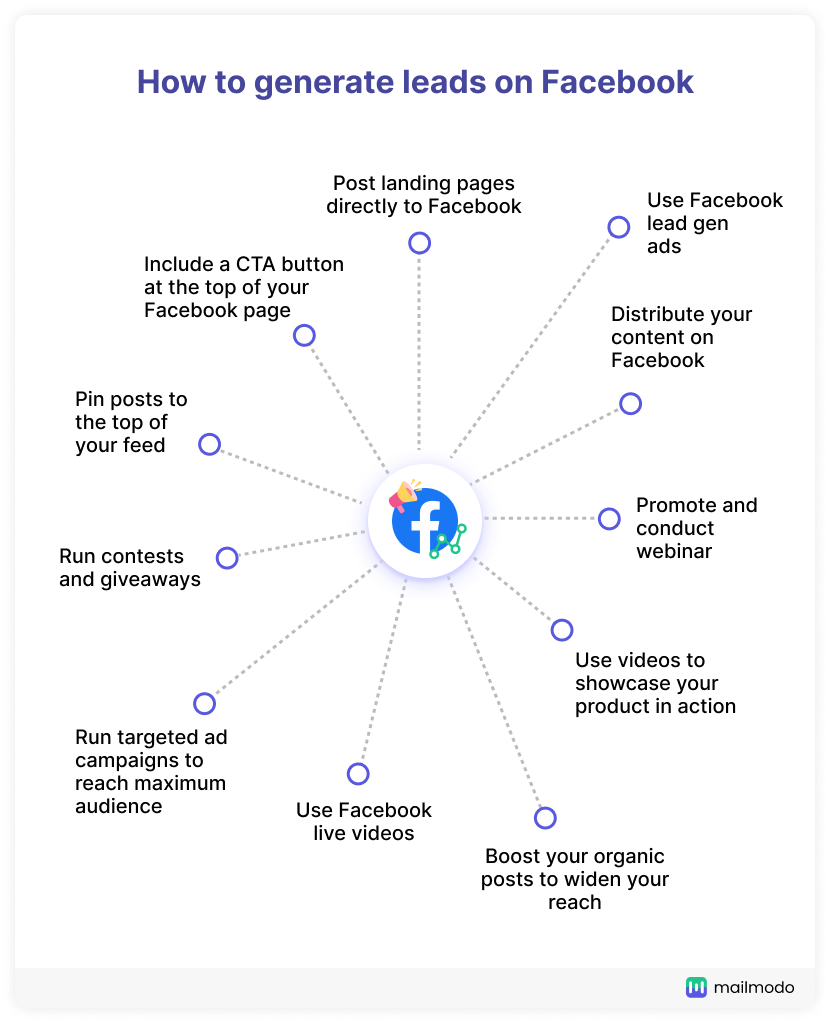
Image Source: MailModo
Here’s how white label Facebook Ads solves those problems.
White Label Facebook Ads Help Agencies Drive Leads for Local Businesses?
White label Facebook Ads fulfillment gives agencies the operational backbone they need to produce reliable results. Instead of worrying about hiring, training, or testing, agencies get a ready-made system managed by specialists.
Let’s break this down into capabilities, playbooks, measurement, and packaging.
A. Core Capabilities White Label Partners Provide
A strong white label partner becomes an extension of the agency. They provide:
- Dedicated Paid Media Strategists: Senior-level media buyers who understand local campaigns, testing cycles, and optimization priorities.
- Creative Production Support: Access to video, UGC, and static ad production tailored to local service niches.
- Audience Research and Buildouts: Custom audiences, lookalikes, interest stacks, radius targeting, and retargeting frameworks built for local intent.
- Technical Setup and Tracking: Meta Pixel, Conversions API, server-side events, and proper event mapping.
- Lead Quality Checks and CRM Integrations: Automated routing using tools like Zapier, LeadsBridge, DashClicks’ CRM software, or native APIs.
- Branded Dashboards and Reporting: White-labeled insights that the agency can share directly with clients, like DashClicks’ White Label Dashboard software.
These capabilities create predictable delivery, faster test cycles, and leaner operational costs. With outsourcing, saving 15 to 30 percent on specialized tasks, agencies maintain strong margins while delivering better performance.
B. Tactical Playbooks That Deliver Local Leads
Below are proven playbooks agencies can use through white label fulfillment partners. Each is designed to run efficiently across multiple clients.
1. Fast-Start Local Lead Funnel
Ideal for service-based businesses like cleaning companies, home repair services, or small clinics.
Steps:
- Build a radius-based target audience with local interest layers.
- Launch ads promoting a direct incentive, such as free estimates or small discounts.
- Use Instant Forms or a simple landing page.
- Push leads directly to CRM with auto-SMS follow-up.
KPIs:
- CTR Target: 1.5 to 3 percent
- CPL: benchmarked against WordStream industry averages
- Lead Response Time: under 5 minutes
Sprout Social reports that short-form video and mobile-friendly paid ads remain among the most effective formats for engagement, reinforcing the value of this funnel.
2. Appointment Push for High-Ticket Local Services
Used for dentists, chiropractors, med spas, and salons that rely on booked appointments.
Steps:
- Run a 45–60 second testimonial or demo video.
- Send traffic to a calendar booking page.
- Integrate automated reminders through SMS or email.
KPIs:
- CPL vs. CPA to book an appointment
- Appointment rate
- Cost per qualified lead (CPQL)
This playbook focuses less on sheer volume and more on qualified intent.
3. Multi-Location Rollout Playbook
Useful for franchises, multi-office businesses, and expanding brands.
Steps:
- Build geo-structured campaigns for each location.
- Use location-specific landing pages.
- Deploy bulk creative variations with local angles.
- Implement GA4 templates and consistent UTM naming.
Metric: CPL stabilizes within the first two weeks once the template is active.
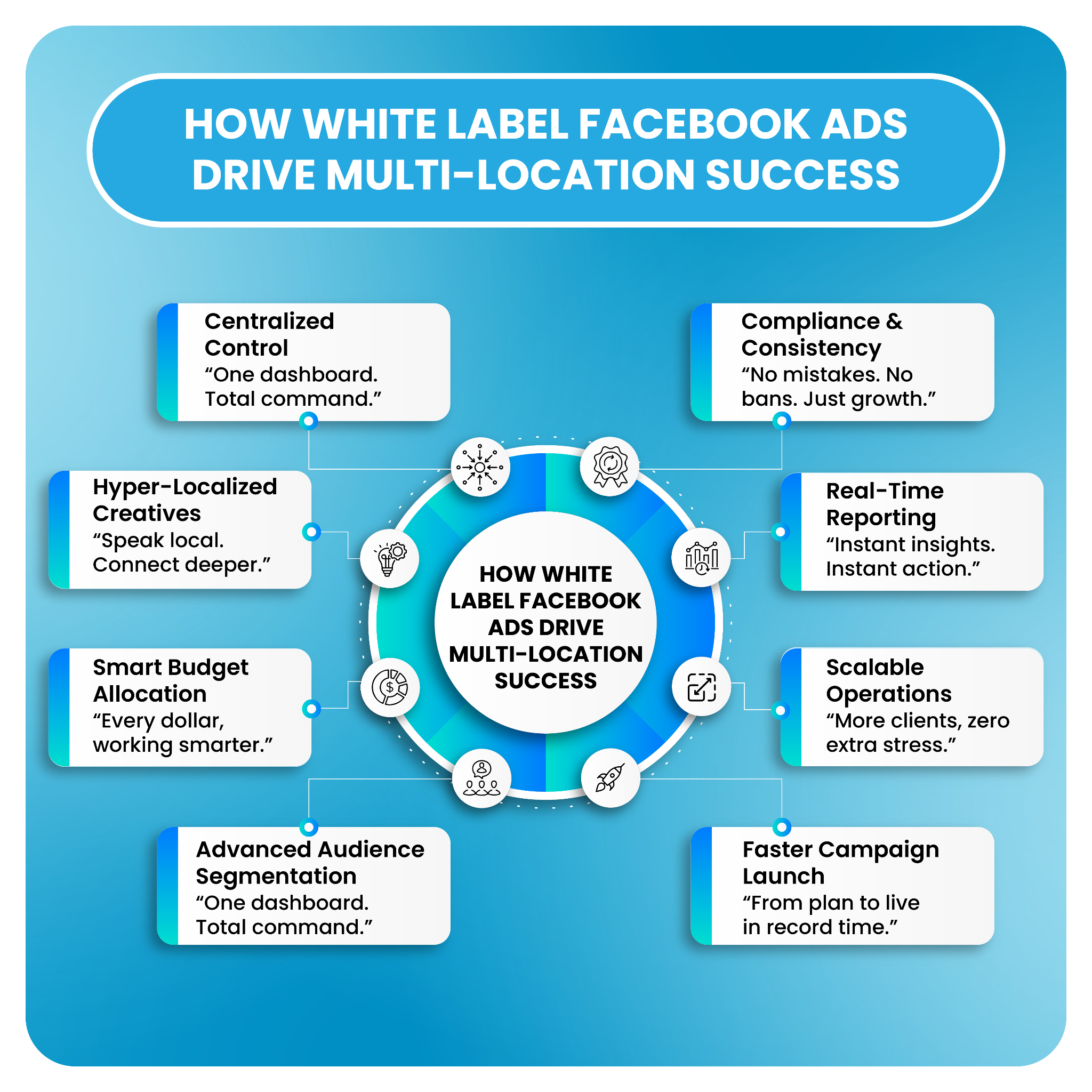
4. Quick-Response Lead Routing
Best for industries where speed matters, such as towing, HVAC, or urgent care.
Steps:
- Push leads to reps instantly.
- Trigger auto-SMS within seconds.
- Set up real-time call routing.
Studies show that contacting a lead within five minutes increases the chance of conversion dramatically compared to a 10-minute delay.
In one modeled example, a three-location home services business boosted lead volume by 2.4 times while reducing CPL by 18 percent after implementing faster routing and structured templates.
C. Creative and Offer Frameworks that Convert Locals
Local audiences respond to clarity, authenticity, and relevance. Strong frameworks help agencies scale creative testing.
Local Proof Triggers:
- Reviews from neighborhood customers
- Before-and-after photos
- Local statistics or seasonal insights
Offer Templates:
- First-visit discounts
- Free mini-audits
- Limited-time local deal
Proven Hooks for Short Videos:
- “Most people in [city] don’t know this…”
- “Here’s how to fix this common issue at home…”
- “A quick tip from a local expert…”
WiserNotify reported that 65 percent of marketers used paid ads to drive leads in the last year, showing the ongoing importance of fresh creatives.
A simple A/B cadence might include three creatives across two audiences, refreshed weekly.
D. Tracking, Attribution, and Lead Quality
Accurate tracking ensures you aren’t optimizing blind.
Essential Setups:
- Facebook Pixel
- Conversion API
- Server-side events
- Offline conversions (especially for appointment-heavy businesses)
- CRM mapping
- Lead scoring
KPIs to Watch:
- Leads
- Qualified leads
- CPQL
- Appointment rate
- Lead response time
- Customer Lifetime Value per customer
- Campaign ROAS
According to WordStream’s industry benchmarks, Facebook is often cheaper for local lead gen compared to search ads, especially for home improvement, beauty services, and personal care.
Tracking should measure customer actions beyond the form submission. The real metric is cost per booked job or appointment.
E. Packaging, Pricing, and Margins for Agencies
A clear pricing structure helps agencies maintain healthy margins.
Common Service Tiers Include:
- Starter: basic campaign setup, simple creatives, monthly reporting
- Growth: ongoing testing, landing pages, advanced creative support
- Enterprise Local: multi-location support, frequent creative updates, CRM consultative support
Pricing Models:
- Flat Retainer
- Percentage of Ad Spend
- Hybrid Structure
Many agencies prefer a retainer plus spend pass-through because it keeps monthly revenue predictable.
Example: If white label fulfillment and creative cost $1,200 per month and the agency charges the client $2,400, the agency earns a solid margin while delivering premium service. Outsourcing savings help maintain a competitive price while still offering advanced capabilities.
F. Onboarding and Retention for Local Clients
Getting clients set up the right way reduces churn and sets expectations.
Onboarding Checklist:
- Access to Business Manager and CRM
- Local business market research
- Baseline audit
- 90-day plan with testing cycles
Retention Tips:
- Monthly reporting that explains outcomes in simple language
- Consistent creative refreshes
- Adding services like local SEO, SMS nurturing, or retargeting funnels
A clear roadmap keeps clients confident during seasonal fluctuations.
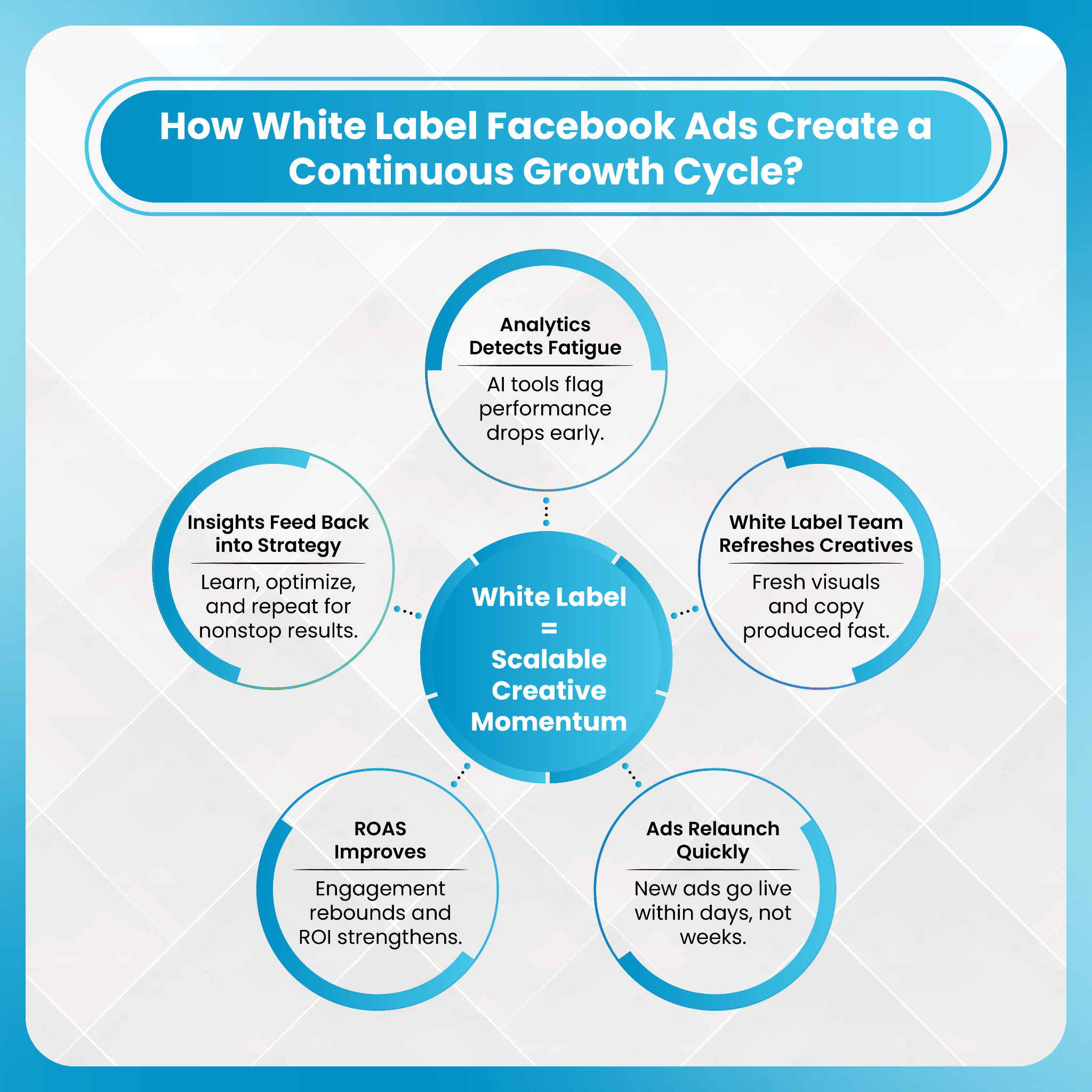
Case Study Walkthrough: A Modeled Local Lead Generation Example
A home renovation company serving a mid-sized city wanted more high-quality leads but struggled with rising CPC and inconsistent creative performance. Their initial CPL was 45 dollars, which put pressure on margins.
What the Agency Did with White Label Facebook Ads Support:
- Ran radius-based targeting focused on homeowners.
- Launched three new UGC video ads plus two static variations.
- Built a landing page with a limited-time estimate offer.
- Set up Conversions API for more accurate tracking.
- Integrated instant CRM routing with SMS follow-up.
- Implemented a five-minute lead response rule.
Results Over 90 Days:
- CTR increased from 1 percent to 2.8 percent.
- CPL dropped from 45 dollars to 32 dollars.
- Lead-to-appointment rate improved with faster response times.
- Conversion to paid jobs increased due to consistent follow-up.
These improvements aligned with WordStream benchmarks for home improvement lead costs, making the performance realistic and credible. With consistent creative testing and proper routing, the agency stabilized results and achieved predictable monthly lead flow.
Quick Tactical Checklist for Agencies
Here’s a simple list agencies can use immediately:
- Set up Meta Pixel and Conversions API correctly.
- Build two audiences to test every cycle.
- Launch at least three creative variations.
- Use a clean UTM structure.
- Ensure leads route to CRM within minutes.
- Set up SMS and email auto-responses.
- Build a local landing page with a clear offer.
- Refresh creatives every 7 to 14 days.
- Track leads past the form into actual appointments.
- Run a monthly analysis on performance by campaign and audience.
These steps help stabilize lead flow and improve long-term performance.
How DashClicks Helps Agencies Implement Effective Facebook Ads Campaigns?
DashClicks gives agencies an end-to-end platform for managing, fulfilling, and scaling Facebook advertising campaigns for local businesses. Instead of juggling scattered tools, agencies get a central dashboard where everything from onboarding to reporting flows seamlessly.
The white label Facebook advertising team handles audience research, technical setup, creative production, campaign optimization, and performance reporting. This allows agencies to offer high-quality Facebook ad services without hiring in-house specialists or managing complicated workflows.
DashClicks also provides automated lead routing, conversion tracking, and CRM integrations so clients get fast follow-up and higher conversion rates. For agencies ready to expand their local lead generation services, DashClicks delivers a scalable fulfillment system backed by experienced media buyers and proven processes.
Conclusion
White label Facebook Ads give agencies a powerful way to deliver steady, scalable lead generation for local businesses without expanding internal teams.
By partnering with specialists, agencies gain access to expert optimization, fresh creative testing, better tracking, and a predictable operational system. This makes it easier to serve more clients, maintain strong margins, and offer high-quality results in competitive local markets.
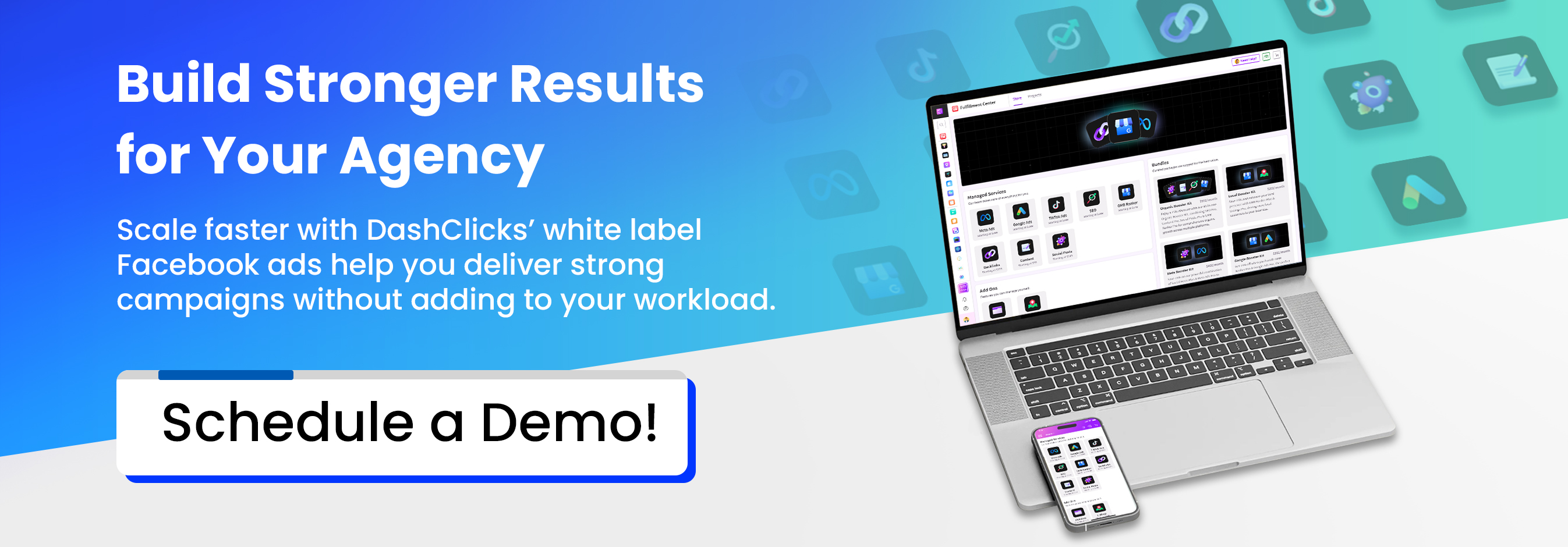

How Small Agencies Use White Label SEO to Compete with Enterprise Agencies
In today’s competitive digital marketing world, small agencies are under more pressure than ever to match the output of much larger firms. Clients expect advanced SEO strategies, detailed reporting, quick turnaround times, and results that show steady progress. These expectations keep rising as the SEO landscape itself grows.
Recent industry data shows just how fast the market is expanding. According to Mordor Intelligence, the global SEO services sector was valued at about USD 74.9 billion in 2025 and is projected to climb to USD 127.3 billion by 2030. This kind of growth brings a mix of opportunity and challenge. Clients are spending more on SEO, which opens the door for agencies to grow their revenue, but it also means those same clients expect a higher level of expertise, consistency, and scalability.
Outsourcing has become a major factor in how agencies adapt. The knowledge process outsourcing market, which includes specialized services like SEO, is expected to reach more than USD 211 billion by 2030. This rise isn’t accidental. Small and mid-sized agencies are relying more on external specialists to handle complex or time-consuming tasks. By doing this, they can keep up with workloads, improve the depth and quality of their delivery, and stay competitive in pitches. Instead of hiring full-time team members for every skill set, outsourcing gives them access to experienced professionals when they need them. The result is the ability to operate with the efficiency of a larger agency without carrying the overhead of one.
The demand for SEO itself remains strong across industries. Research from Conductor shows that nearly all organizations see clear, measurable impact from their SEO efforts, whether through increased organic traffic, stronger engagement, or higher conversion rates. For agencies, this makes SEO one of the most reliable services for long-term retention and recurring revenue. When clients see consistent organic growth, they stay longer and often expand their services.
The challenge for many smaller agencies is delivering that level of enterprise-grade SEO on a consistent basis. It requires time, tools, expertise, and a team that can scale as client needs grow. That’s where white label SEO becomes a practical solution. Instead of spreading their internal team thin or turning away business, agencies can partner with a white label provider who handles strategy, execution, reporting, and optimization behind the scenes. This allows them to offer high-quality SEO under their own brand while maintaining the output, depth, and reliability that clients expect from larger firms.
As the SEO market continues to grow and client expectations evolve, white label SEO partnership are becoming one of the most effective ways for smaller agencies to stay competitive, expand their capabilities, and deliver results that truly stand out.
What Small Agencies Face Compared to Enterprise Agencies?
Running a full SEO operation requires a lot of specialized roles. A small agency often doesn’t have the budget to hire technical SEO experts, trained writers, link builders, and strategists. Recruiting top-tier talent can take months and usually comes with high salaries.
Beyond staffing, there’s a technology gap. Enterprise agencies utilize premium crawling tools, AI-powered analysis platforms, automation stacks, and reporting software that can cost thousands of dollars each year. Smaller teams may rely on basic tools, which makes it harder to compete.
Then there's scale. Handling multiple SEO clients at once takes strong systems, consistent quality control, organized project management, and ongoing optimization. Many small agencies struggle once client volume increases or projects become more complex, especially with multi-location businesses.
Clients today also expect clear communication, transparency, and fast results. They want ongoing insights, accurate monthly reporting, and strategic recommendations. Meeting these expectations can be difficult for lean teams.
Quality inconsistency is another concern. Junior staff or freelancers may deliver variable output, which risks damaging results and client trust. Because of all this, outsourcing becomes economically attractive.
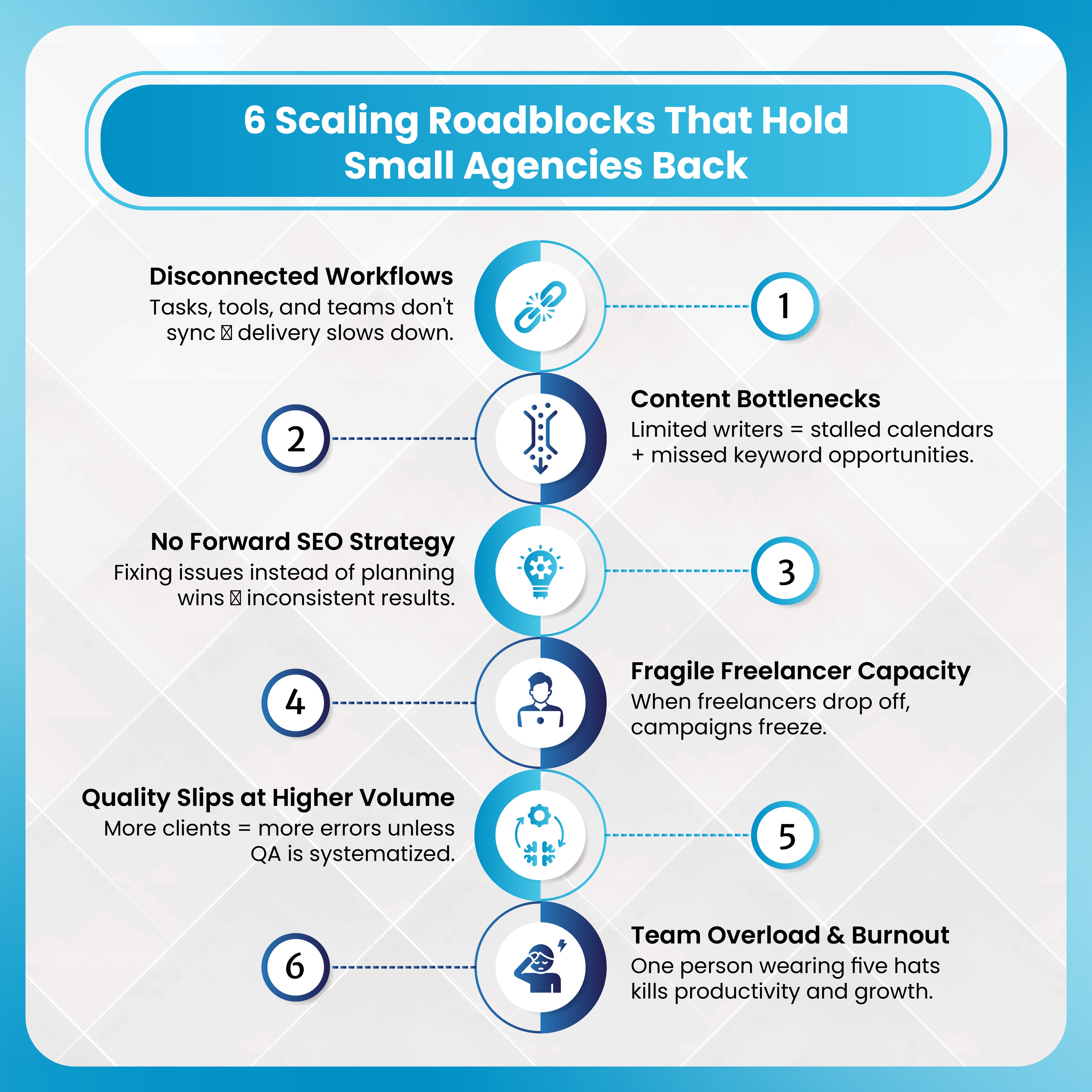
Studies like those from Hire with Near show that outsourcing can reduce costs by 30–70% compared to in-house hiring, making it a practical solution for smaller agencies that need reliable performance.
How White Label SEO Levels the Playing Field?
White label SEO lets smaller agencies operate at the same level as bigger firms without increasing overhead. Instead of hiring specialists, they lean on an external team that works behind the scenes while everything stays under the agency’s brand. This setup gives them the skill, capacity, and structure they need to take on more clients and offer a broader range of services.
1. What White Label SEO Provides?
A good white label partner brings senior-level expertise across all the major areas of SEO. This includes technical work like crawl optimization and site performance, as well as content strategy and link acquisition. Agencies also get access to premium tools that would be expensive to buy on their own.
Another advantage is speed. They can onboard new clients quickly because the fulfillment team already has established workflows. Predictable SLAs give agencies the confidence to promise steady delivery and consistent results.
2. Capabilities Agencies Gain
With a white label SEO provider, agencies can offer services that normally require a full in-house team. These often include:
- Deep technical audits, solutions for crawl and indexation issues, and improvements to site speed.
- Scalable content strategies built around topics, clusters, briefs, and quality production.
- Manual link acquisition from reliable publishers.
- Support for multi-location SEO for clients, including site structure and landing page strategy.
- Branded dashboards and automated reporting that look like they came from the agency’s own team.
A practical example shows how powerful this model can be. A small three-person agency once partnered with a white label SEO provider to execute a six-month content program for a regional franchise. The franchise saw its organic traffic triple, and the agency kept a 40 percent margin on the work. Achieving something like this alone would have required multiple hires and far more bandwidth.
3. Measurable Business Outcomes
White label SEO can lead to faster, more reliable results because the work is handled by teams that specialize in execution. Many clients see ranking improvements within three to six months. Costs stay low because agencies don’t have to pay salaries, benefits, or tool subscriptions, which often leads to savings between 30 and 70 percent.
Retention also increases since SEO is an ongoing service that compounds over time. Strong deliverables help agencies compete for larger contracts and pursue enterprise-level opportunities that would otherwise be out of reach.
4. Packaging and Pricing White Label SEO
A tiered structure is one of the easiest ways to package these services. Agencies often set up plans such as:
- Starter options with a small keyword set and basic deliverables.
- Growth plans with stronger content production and link building.
- Advanced packages that include technical audits, link acquisition, and more strategic work.
Margins typically fall between 40 and 70 percent, depending on how much value the agency adds on top. Clear expectations around SLAs, review cycles, and reporting are important for smooth delivery. Once the results start to show, upselling becomes natural. Agencies can add content, local SEO, or conversion-focused audits without hiring new staff.
5. Operations and Workflow Management
Running white label SEO effectively comes down to having clean internal processes. Onboarding should include access collection, goal setting, an initial audit, and a clear timeline.
Regular quality checks help keep content and link-building standards consistent. Monthly reporting gives agencies a chance to explain progress and strengthen client relationships. Good NDAs and security practices keep the partner invisible and ensure the agency’s brand remains front and center.
By integrating white label SEO into their operations, small agencies can scale confidently, take on bigger challenges, and deliver results that stand up against the industry’s leading firms.
How Small Agencies Win Enterprise Clients?
White label SEO agency improves more than delivery. It also strengthens how a small agency presents itself in the market:
- Enterprise-level audits, structured documentation, and detailed reporting help the agency appear more established and experienced.
- Clients notice the shift right away because they see deeper analysis, stronger technical insights, and strategies that resemble work from a large in-house SEO team.
- The credibility boost is significant since a white label SEO partner provides systems, SOPs, and case studies that the agency can use in prospecting and proposals.
- Agencies can confidently approach bigger opportunities, including national brands, multi-location businesses, and complex websites.
- Proposal writing becomes easier with ready-made frameworks for technical breakdowns, keyword forecasting, competitive insights, and long-term content planning.
- These elements make the agency look like a specialized SEO partner rather than a small local provider.
- The quality of the proposal itself becomes a differentiator because enterprise clients expect depth and clarity.
- Using white label SEO in both delivery and positioning helps small agencies compete in higher-value markets without growing their internal team.
The Margin Engine Behind White Label SEO
- White label SEO services help agencies improve margins by replacing full-time hires with pay-as-needed fulfillment.
- The cost of one senior SEO employee can equal an entire month of white label work, especially once tools, training, and management time are included.
- In-house teams come with fixed, ongoing expenses such as salaries, software, and employee development.
- White label SEO fulfillment removes most of that overhead and lets agencies scale work up or down based on client demand.
- Tiered retainers give agencies predictable fulfillment costs and make it easier to maintain strong margins.
- This predictability supports steady growth and better financial planning.
- With fulfillment handled in the background, agencies can focus on cross-selling services like PPC, web development, and branding.
- SEO becomes the backbone of higher retention, more upsells, and stronger profitability.
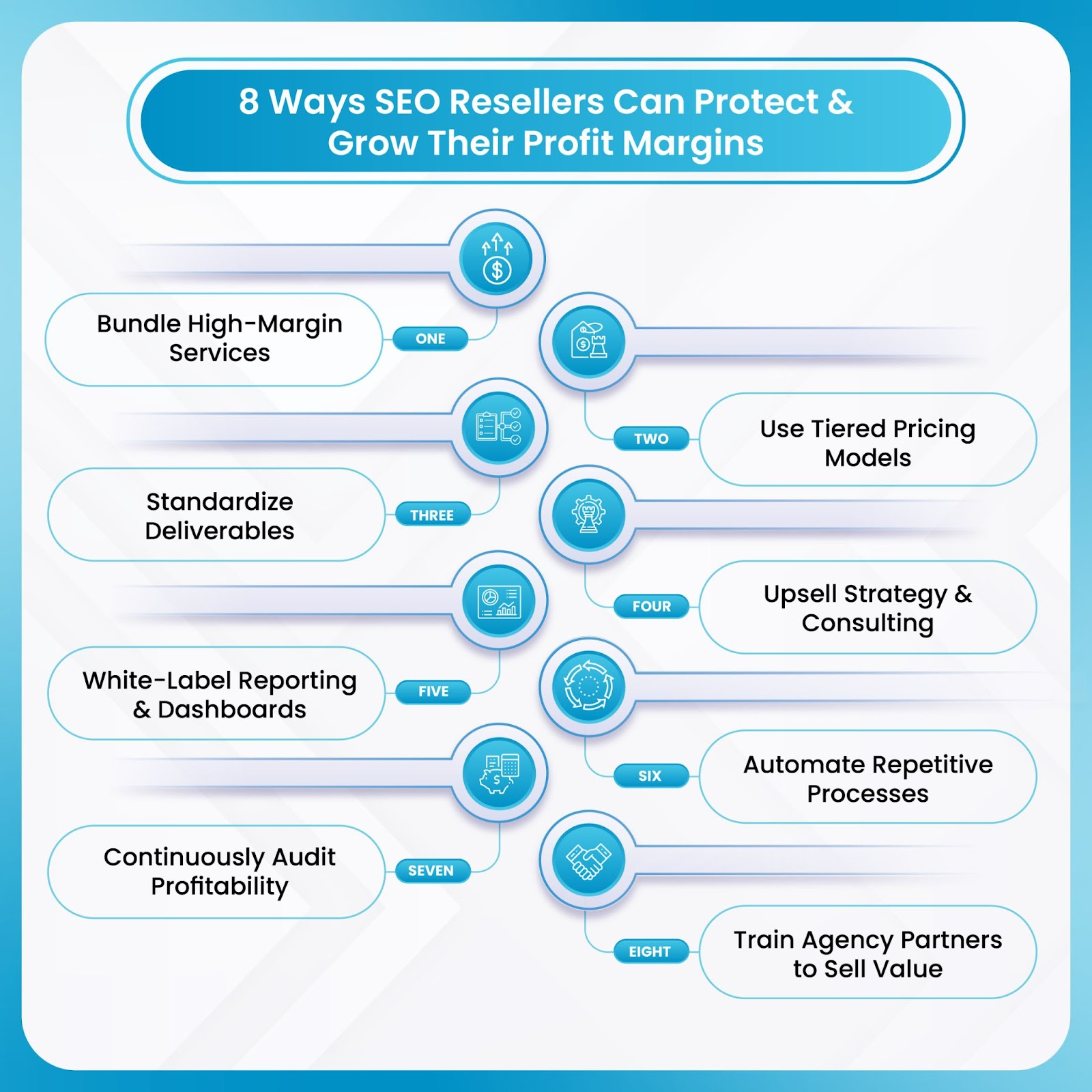
Competitive SEO Edge: Advantages Gained Overnight
White label SEO gives small agencies access to capabilities that would normally take months of hiring, training, and tooling to build internally. Instead of stretching limited resources, you can plug into a fully developed SEO operation and deliver high-level results right away.
Here’s what that looks like in practice:
1. Enterprise-Level Technical Diagnostics: You get access to deep crawl insights, site health audits, speed analysis, indexation checks, and error-resolution workflows that match what large agencies use. This lets you identify issues quickly and deliver fixes your clients can see.
2. Complete Content Ecosystems: From keyword research for SEO to content briefs, writing, optimization, and publishing support, you gain a full content engine without hiring writers or strategists. It becomes easier to publish consistently and target opportunities across the funnel.
3. Multi-Location Rollouts: Local SEO for businesses with dozens or hundreds of locations becomes manageable. You get bulk optimization processes, listing management, citation cleanup, and scalable location-page strategies.
4. Digital PR and Manual Outreach Capabilities: Instead of trying to build your own outreach team, you can tap into established relationships and proven processes for acquiring high-quality backlinks. This helps smaller agencies compete with larger players right away.
5. Schema Setups Across Large Sites: Structured data implementation can be time-consuming, especially for e-commerce or enterprise sites. White label SEO partners handle this with precision, improving visibility and eligibility for rich results.
6. Advanced Competitor Research: Robust competitor research tools and trained analysts give you insights into competitor gaps, content opportunities, backlink profiles, and emerging trends. You can offer clients strategic recommendations backed by real data.
7. Faster Turnaround Times: Because the fulfillment engine is already built, your projects move quickly. Clients see faster wins, and you spend less time managing production.
These advantages normally require multiple in-house employees to execute consistently. With white label SEO services, small agencies can offer all of this without expanding their team, which helps them stay competitive and increase margins.
White Label SEO as a Differentiator
- White label SEO lets smaller agencies compete at a higher level without needing a large in-house team.
- Clients get boutique-level attention supported by the technical expertise of a larger operation.
- It removes hiring risk because agencies don’t need to manage changing workloads or long training cycles.
- Agencies avoid the cost of bringing on specialized SEO roles.
- They can take on projects they might normally decline, including work in SaaS, legal, finance, and real estate.
- A white label SEO partner helps them shift from limited capacity to a scalable SEO operation.
- It creates room to pursue bigger clients and offer more services.
- Agencies can deliver strong, consistent results while keeping the personal touch that makes them unique.
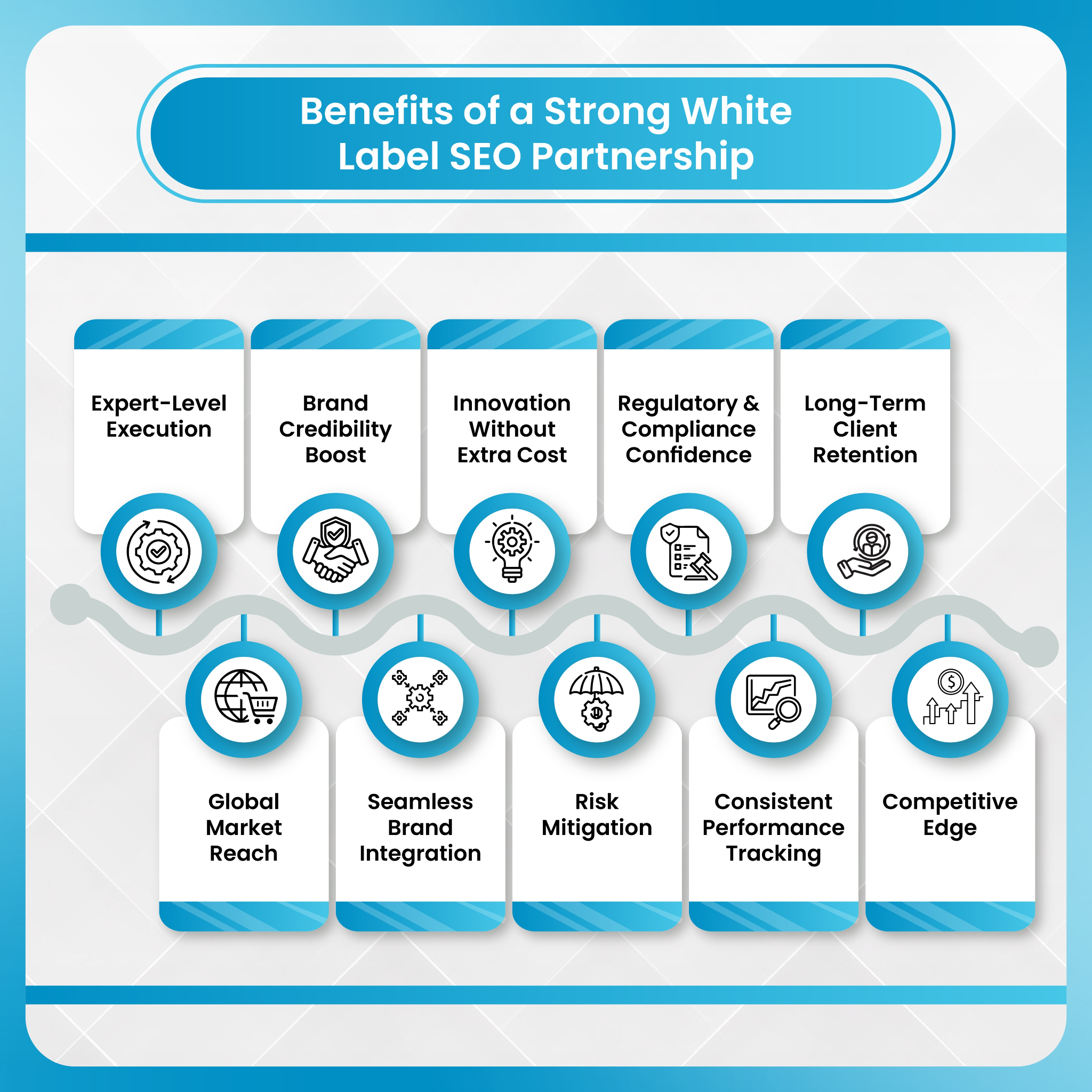
How DashClicks' White Label SEO Services Helps Small Agencies Compete?
DashClicks gives small agencies the kind of infrastructure that usually belongs to larger, well-resourced firms. Everything runs under the agency’s own brand, so clients see a smooth, professional experience without knowing there’s a fulfillment team behind the scenes.
Their white label SEO services cover the full workflow: audits, on-site optimization, content production, and link building. Agencies also get access to onboarding tools, client sub-accounts, and real-time reporting dashboards. Clients can log in, check rankings, review tasks, and see progress, all without any reference to DashClicks. Dedicated account managers handle each order, which helps keep campaigns consistent and reduces the chances of mistakes slipping through.
A key advantage is flexibility. DashClicks doesn’t lock agencies into contracts, minimum spends, or bulk commitments. You can start with a single SEO client and scale up as you grow. The process is structured but simple. It begins with an onboarding review, moves into campaign setup and technical fixes, and then shifts to ongoing optimization, content updates, and monthly performance improvements.
For agencies that want steady recurring revenue without expanding their internal team, DashClicks provides a system that’s easy to plug into. You stay in full control of client communication and strategy while their team handles the heavy lifting. This lets smaller agencies deliver enterprise-level SEO at scale while keeping their operations lean and efficient.
Conclusion
White label SEO allows small agencies to operate at a level that rivals much larger firms, without the need to hire a big team or invest heavily in tools and infrastructure. It gives agencies a clear competitive edge by improving the quality, speed, and consistency of their SEO services while keeping operational costs under control.
With access to professional fulfillment, agencies can confidently take on larger clients, retain accounts longer, and explore new verticals or service offerings that were previously out of reach. The flexibility and scalability of white label SEO let small teams focus on strategy, client relationships, and growth rather than execution alone.
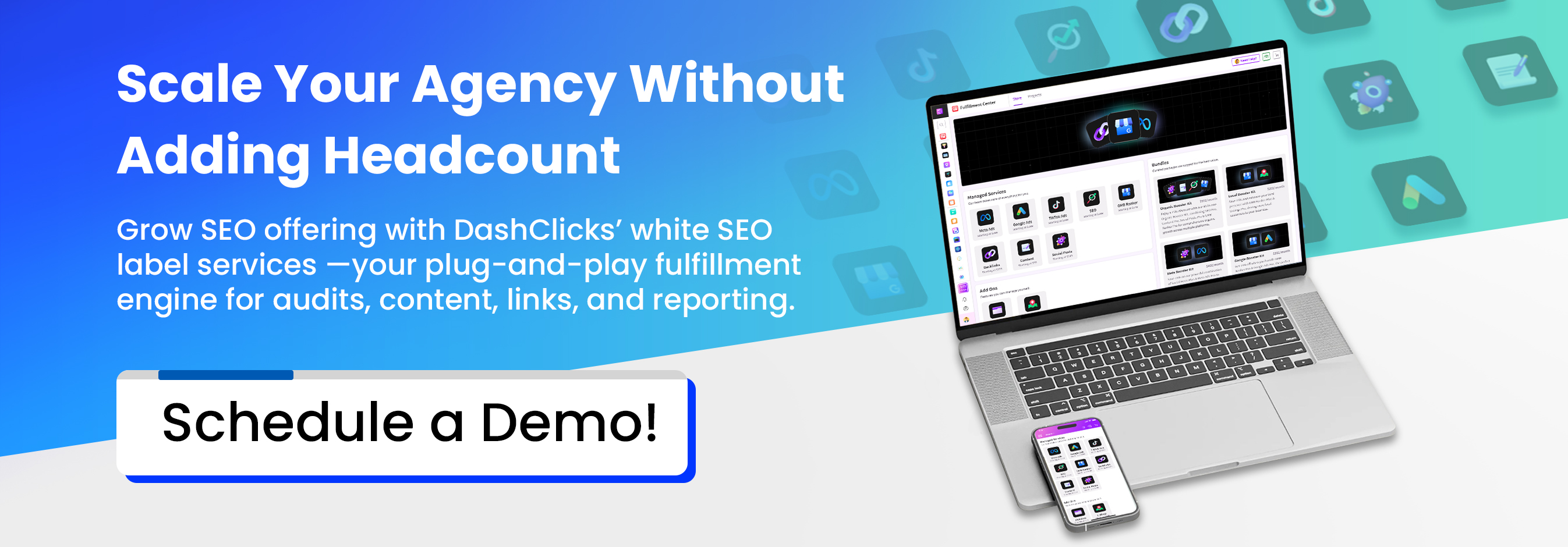

The Agency Playbook for White Label SEO Pricing: From Flat Rates to Value-Based Models
White label SEO services rely on agencies to successfully grow. It allows agencies, web firms, and even freelancers to offer a real SEO service to clients, and at the same time, without hiring an in-house SEO team.
However, one of the biggest challenges for agencies is figuring out a pricing structure for their white label SEO services that will still keep the agency profitable, competitive, and earn bonus points if they deliver any real value!
Understanding White Label SEO Pricing Models
Before we get into the money world, it is relevant to understand that pricing strategies for white labeling are not universally applicable.
Agencies adopt models that are consistent with their intended niche, service depth, and value offering. To manage these models efficiently, many service businesses use dynamic pricing infrastructure frameworks. This approach automates tiered and hybrid billing, helping agencies link revenue directly to deliverables, track margins transparently, and scale client accounts without manual recalculation.
Just as White label AI agents help automate client communication and reporting, these frameworks help agencies run leaner operations and focus on growth rather than micromanagement.
Here are the three most common pricing models.
1. Flat-Rate Pricing
A lot of agencies typically prefer a fixed monthly fee for certain deliverables. For example, the agency could offer a $ 300-per-month starter SEO package that includes deliverables such as on-page optimization, link building, and monthly reports.
Pros:
- Predictable revenue stream.
- Easy for clients to understand and budget.
- Simplifies project management.
Cons:
- Limited flexibility if client requirements vary.
- Profit margins can shrink if the white label provider increases rates or the client demands more work.
2. Tiered Packages
One of the most popular pricing structures for white label SEO is allowing agencies to create multiple packages, such as Basic/Standard/Premium packages, and Premium packages, each with a different level of service.
Example:
- Basic ($300–$500/month): Local SEO, basic keyword targeting, citation building.
- Standard ($700–$1,000/month): On-page + off-page optimization, monthly blog posts, technical audits.
- Premium ($1,500+/month): Complete SEO, content strategy, advanced analytics, and link outreach.
Why does it work: It provides agencies with the ability to service small businesses and larger organizations while fueling scalable profit margins.
3. Cost-Plus Pricing
With this model, agencies will take the base cost that they are charged from the white label provider, and then they will build in a markup for their profit, overhead, etc.
For example, if a provider offers a monthly SEO package for $400, the agency may charge the client $800 - $1,000 based on the support provided and the agency’s own branding.
Formula: Final Price = Provider Cost + (Markup Percentage × Provider Cost)
Advantages:
- Transparent and easy to calculate.
- Ensures consistent profit margins.
The critical factor here is value justification. The client must feel that the agency’s participation has added value to justify the markup.
4. Performance-Based Pricing
Some agencies price their services based on measurable results such as keyword rankings, website traffic, or conversions.
For example:
- $100 per keyword ranked in the top 10.
- $50 per 1,000 organic visits increase per month.
While this sounds appealing to clients, it’s riskier for agencies since SEO results depend on multiple variables. Agencies using this model often combine it with a base retainer to protect their revenue.
5. Custom or Project-Based Pricing
For SEO projects that only happen once, like audits, site migrations, or link cleanup, agencies tend to quote on a flat project basis. This can vary depending on the project scope, ranging from $500 to $5,000 (or sometimes more).

This works well for specialized agencies focused on offering high-value technical SEO solutions or consulting.
Key Factors That Influence White Label SEO Pricing
- Provider Costs: Each white label SEO provider is going to charge different prices based on the elements included, their expertise, and the quality of the work being provided. Agencies should have an idea of how much they are spending per client to avoid selling themselves short.
- Scope of Services: A campaign focused on local SEO for a small business will cost considerably less than a full-scale e-commerce SEO project that requires ongoing content and link building. Which businesses benefit from local seo practices? Local shops, restaurants, and service-based companies often gain the most. Local SEO helps them reach nearby customers actively searching for their products or services, driving real foot traffic and online conversions.
- Target Market: Budgetary expectations of your clients are one of the key considerations. An agency that works with startups or small, local businesses will need to have lower-priced options, while an enterprise account will expect to pay for premium-level service.
- Competition: If your competitor was offering SEO services for a lower rate than you, you'll need to make a case for your pricing with superior deliverables, full transparency, or a guarantee of performance.
- Overheads and Brand Value: Don't forget internal costs for client management, reporting, sales efforts, and communication. Investing in Team Communication tools like DashClicks’ Conversation Software can help streamline these internal processes, improving coordination and reducing inefficiencies.
Even if the white label provider is completing the work, the agency's work represents value that needs to be compensated.
How to Create “Perceived Value” That Justifies Higher Pricing?
Most agencies think pricing is about numbers, margins, and deliverables. In reality, pricing is 50% math and 50% psychology. Clients don’t pay more just because you do more work—they pay more when they feel they are getting a premium, reliable, and well-managed experience.
This is where perceived value allows agencies to charge 30%–150% higher markups on white label SEO packages without pushback. The goal is simple: make the client experience so smooth, organized, transparent, and professional that your price feels justified.
Here are the biggest drivers of perceived value:
1. Client Onboarding Experience
A polished client onboarding experience immediately signals that the client is in capable hands. When an agency provides structured intake forms, clear timelines, kickoff calls, and branded welcome materials, it creates a sense of professionalism from day one. Clients interpret this level of organization as a reflection of how their SEO campaign will be managed, making them far more comfortable paying a higher monthly fee.
2. Custom Reports With Branding
Visually appealing, branded reports elevate how clients interpret the quality of the work being done. Instead of generic spreadsheets or unformatted PDFs, a well-designed, agency-branded report communicates expertise and attention to detail. Clients often associate good design with better insights and better service, increasing their willingness to pay more for what feels like a premium deliverable.
3. Personalized Strategy Calls
Strategy calls add a human layer to the service that clients genuinely value. When an agency takes time to walk clients through progress, explain decisions, and offer guidance, it transforms the relationship from transactional to consultative. Clients feel supported, informed, and understood — and they naturally become more open to higher pricing because they’re not just paying for tasks, but for insight and expertise.
4. Quarterly Roadmaps
A quarterly roadmap helps clients visualize the long-term direction of their SEO campaign. It clearly outlines what has been completed, what’s planned next, and how each step contributes to their goals. This forward-looking transparency eases concerns about slow SEO timelines and reassures clients that their investment aligns with a strategic plan — making premium rates feel justified rather than questioned.
5. Dedicated Client Portals
Client portals add a level of transparency that removes uncertainty from the relationship. When clients can log in to view their reports, deliverables, tasks, updates, and communication history, they feel like they have complete visibility into the agency’s workflow. This access reduces doubts and reinforces the perception that the agency is structured, dependable, and worthy of higher fees.
6. Data Transparency
Clients who feel informed are far less likely to question pricing. By giving clear explanations of ranking changes, traffic fluctuations, completed tasks, and campaign decisions, agencies show accountability. This kind of transparency builds trust, and trust directly increases a client’s willingness to pay a premium since they never feel “in the dark” about the value being delivered.
7. White Glove Communication
High-touch communication is one of the strongest drivers of perceived value. When clients receive timely responses, proactive updates, simplified explanations, and consistent check-ins, they feel genuinely cared for. This level of attention makes the service feel luxurious rather than basic, giving agencies the freedom to maintain higher pricing without resistance.
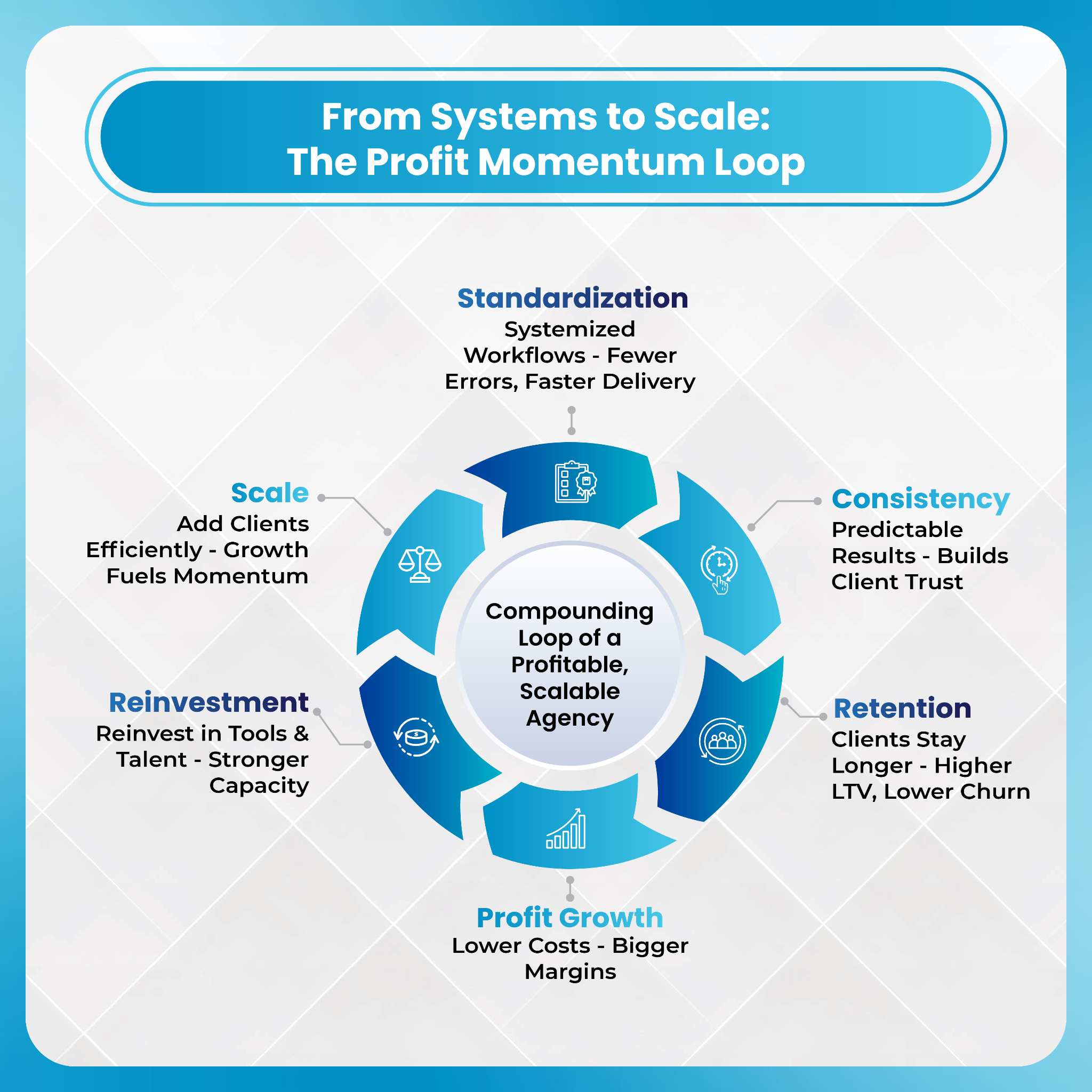
How Agencies Maintain Profitability?
1. Smart Markups
The white label SEO industry frequently defaults to a standard markup of 30%-70%. That said, when working with premium agencies that typically provide consulting, analytics, and branding support, markups can easily exceed 100%. Partnering with marketing staffing agencies can also help strengthen your operational capacity without inflating overhead costs, allowing teams to scale efficiently while maintaining profitability.
The real key is not competing on price, but on perceived value. The more personalized and transparent your service seems, the more easily you can defend eight-figure-type markups.
2. Streamlined Operations
Reporting, keyword tracking, project management, and client communication automation tools cut costs improving agency operations.
The more time your internal staff doesn't have to spend managing campaigns, the better your profit margins will be.
3. Transparent Reporting
Agencies that provide white label dashboard or branded reports build trust, which leads to less churn.
Clients who stay longer mean more long-term profitability, even if margins are smaller.
4. Choosing the Right Provider
Always choose providers that offer the following.
- Scalable SEO solutions
- Transparent deliverables
- Data-driven performance reporting
- Dedicated account support
5. Upselling and Cross-Selling
It is common for firms to offer SEO plus some other services like web design, PPC, or social media management since this strengthens their revenue stream and builds stronger client loyalty.
For example, combining “SEO + Content Marketing” can justify charging clients 20–30% more than SEO-only services.

Dangerous Pricing Mistakes Agencies Make (and How to Avoid Them)
Even with the right pricing model, many agencies unknowingly fall into traps that slowly destroy their margins. These mistakes are common, costly, and completely avoidable once you know what to look for. Understanding them helps agencies price confidently, protect profitability, and maintain long-term client relationships.
- Underpricing to “Win Clients”: Many agencies start with low prices to attract clients, but this approach rarely works long term. Underpricing signals low value, attracts high-maintenance clients, and leaves no room to cover provider costs or internal labor. Pricing based on value rather than fear leads to healthier, more sustainable growth.
- Ignoring Provider Price Changes: White label SEO provider occasionally increase their rates, and agencies who fail to adjust client pricing end up absorbing the difference. Over time, this quietly cuts into profitability. Reviewing costs quarterly and updating client pricing annually keeps your margins intact.
- Offering Too Many Deliverables in Low-Tier Plans: Trying to impress clients with “loaded” starter packages often backfires. Overstuffed low-tier plans drain resources, prevent upsells, and blur the line between basic and premium offers. Entry-level packages should stay lean, while advanced deliverables remain in higher tiers.
- Having No System for Scope Creep: Without clear boundaries, clients quickly push past the agreed scope with extra requests, revisions, or “quick fixes.” A defined scope, paired with upgrade paths or change fees, prevents small tasks from snowballing into margin killers.
- Not Defining Guaranteed vs. Non-Guaranteed Services: Agencies sometimes promise outcomes—like ranking timelines—that no SEO provider can guarantee. This leads to conflicts, discounts, or free extra work. Clarifying what is guaranteed (deliverables, reporting, communication) versus what is not (specific rankings or speed of results) protects both sides.
- Charging the Same Price Across All Industries: Different niches require different levels of work. A local bakery and a competitive legal firm should not pay the same rate. Industry difficulty, competition, and search volume should influence pricing to keep campaigns profitable and realistic.
Smarter Way for Agencies to Deliver SEO: DashClicks’ White Label SEO Services
DashClicks provides fully managed white label SEO services designed to help agencies scale without hiring internal SEO staff. Their fulfillment team handles core tasks like keyword research, on-page optimization, content creation, technical fixes, and link building, allowing agencies to deliver complete SEO campaigns under their own branding.
What makes DashClicks stand out is its unified dashboard. Agencies and their clients can track deliverables, rankings, reports, and campaign progress in real time, all displayed inside a clean white label portal. This eliminates manual reporting and strengthens transparency — a key factor in client retention.
For agencies managing multiple accounts, DashClicks offers predictable workflows, standardized deliverables, and consistent quality. It’s a plug-and-play SEO fulfillment model that supports both new and growing agencies, making it easier to scale operations, increase margins, and maintain a professional client experience.
Wrapping It Up
There’s nearly as much art as there is science in pricing white-label SEO services for profit. The most successful agencies don’t just put a simple markup on the provider cost. They create the perceived value through communication, branding, reporting, and customer care.
Regardless of whether you're providing tiered packages, project-based pricing, or value-based pricing, the outcome should be the same: consistently delivering results, being transparent, and scaling profitably.
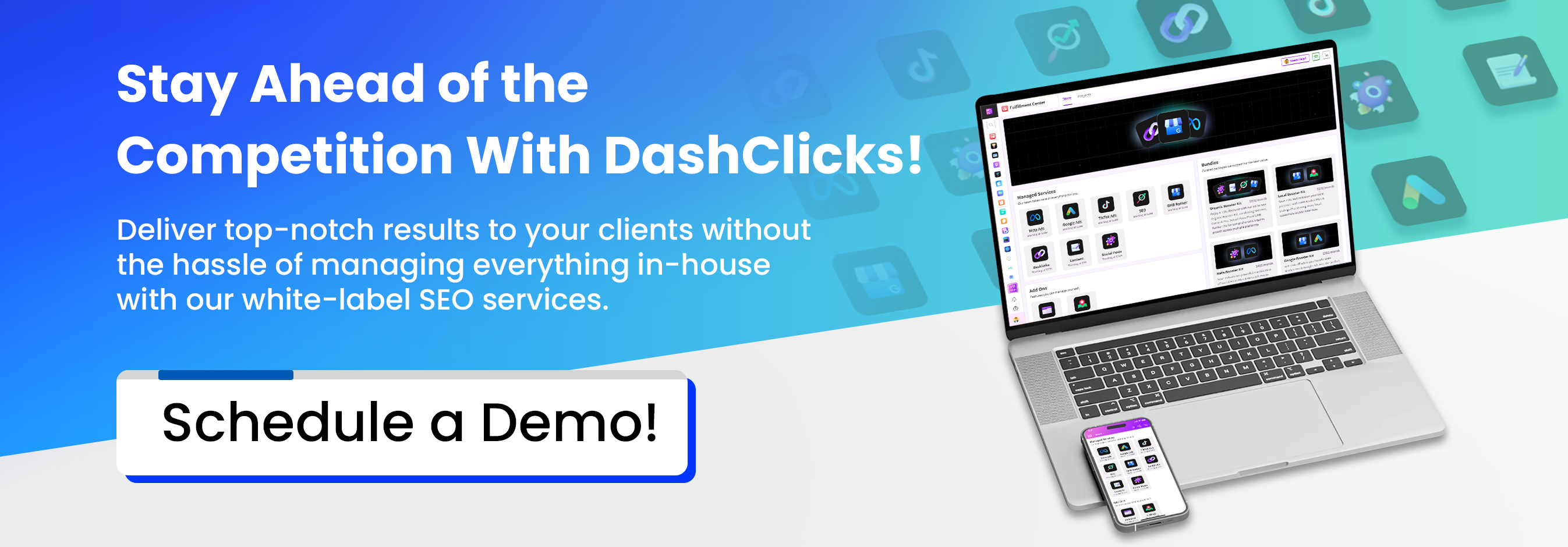

No results found.
Please try different keywords.
Get Started with
DashClicks Today
Get found online, convert leads faster, generate more revenue, and improve your reputation with our all-in-one platform.
.svg)
Unlimited Sub-Accounts
.svg)
Unlimited Users
.svg)
All Apps
.svg)
All Features
.svg)
White-Labeled
.svg)
Active Community
.svg)
Mobile App
.svg)
Live Support
.svg)
100+ Tutorials
.svg)
Unlimited Sub-Accounts
.svg)
Unlimited Users
.svg)
All Apps
.svg)
All Features
.svg)
White-Labeled
.svg)
Active Community
.svg)
Mobile App
.svg)
Live Support
.svg)
100+ Tutorials
.svg)
Unlimited Sub-Accounts
.svg)
Unlimited Users
.svg)
All Apps
.svg)
All Features
.svg)
White-Labeled
.svg)
Active Community
.svg)
Mobile App
.svg)
Live Support
.svg)
100+ Tutorials



.svg)
.svg)
.svg)
.svg)
.svg)


